This is the website of Abulsme Noibatno Itramne (also known as Sam Minter).
Posts here are rare these days. For current stuff, follow me on Mastodon
|
It may well be that Clinton bottomed out and is now strengthening daily in the Democratic primary race, but her declines have not stopped on the general election front… at least not yet. The latest batch of polling shows her continuing to weaken against Rubio, in North Carolina this time:
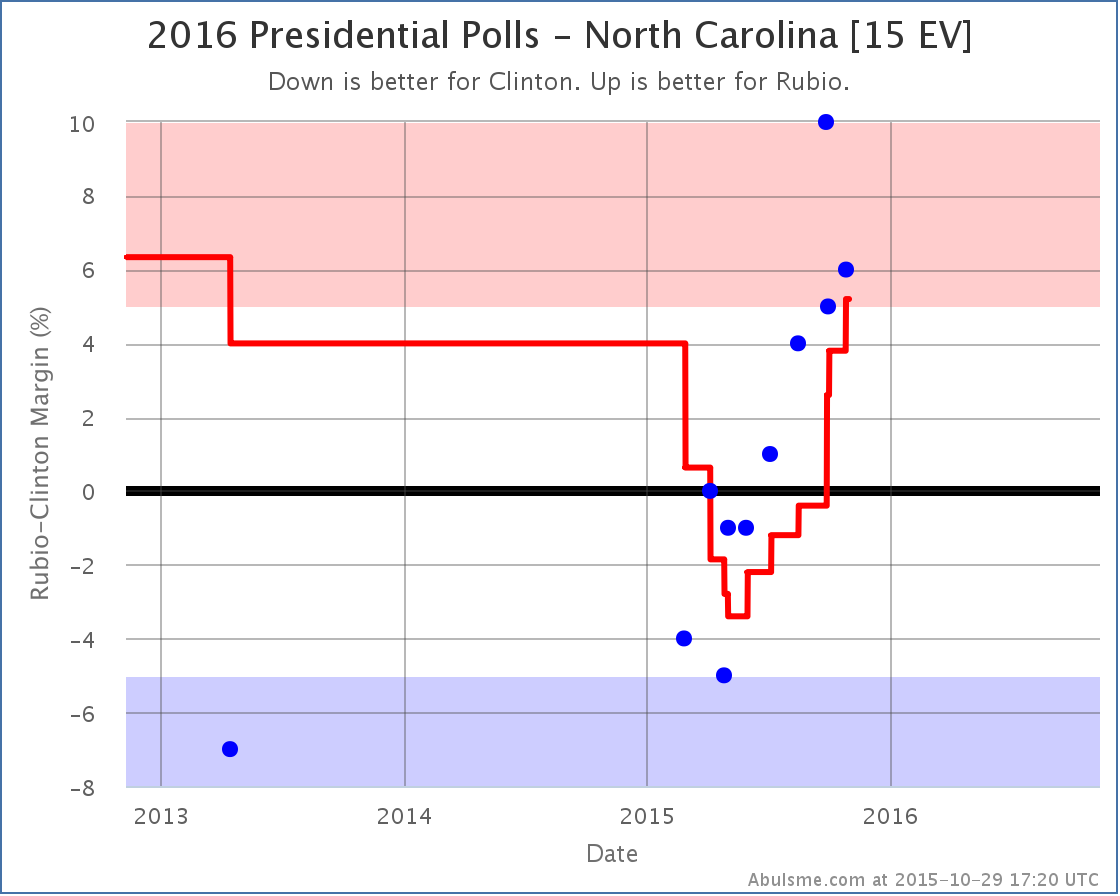
The trend toward Rubio has continued for over 5 months now. With this latest update, the poll average has Rubio with a 5.2% lead. That is enough for us to take North Carolina out of the list of states that could go either way, and just give it to Rubio. For the moment anyway.
Insert here the usual reminder of just how far it is until the election and how things can change quickly.
In any case, this weakens Clinton’s “best case” a bit, leaving us with this:
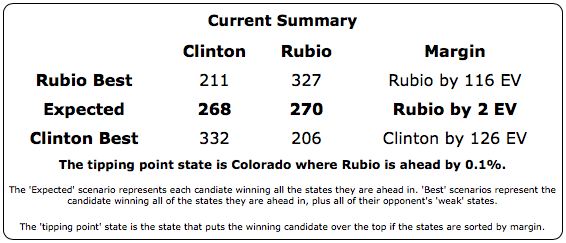
Clinton losing North Carolina from her “maybe” column makes this already close matchup look even closer. Right now Rubio does better against Clinton than any of the other “five best polled” candidates, and that race is neck and neck.
We haven’t looked at a map in awhile here, so a quick look at what a neck and neck race with the Republican just barely eking out a win looks like:
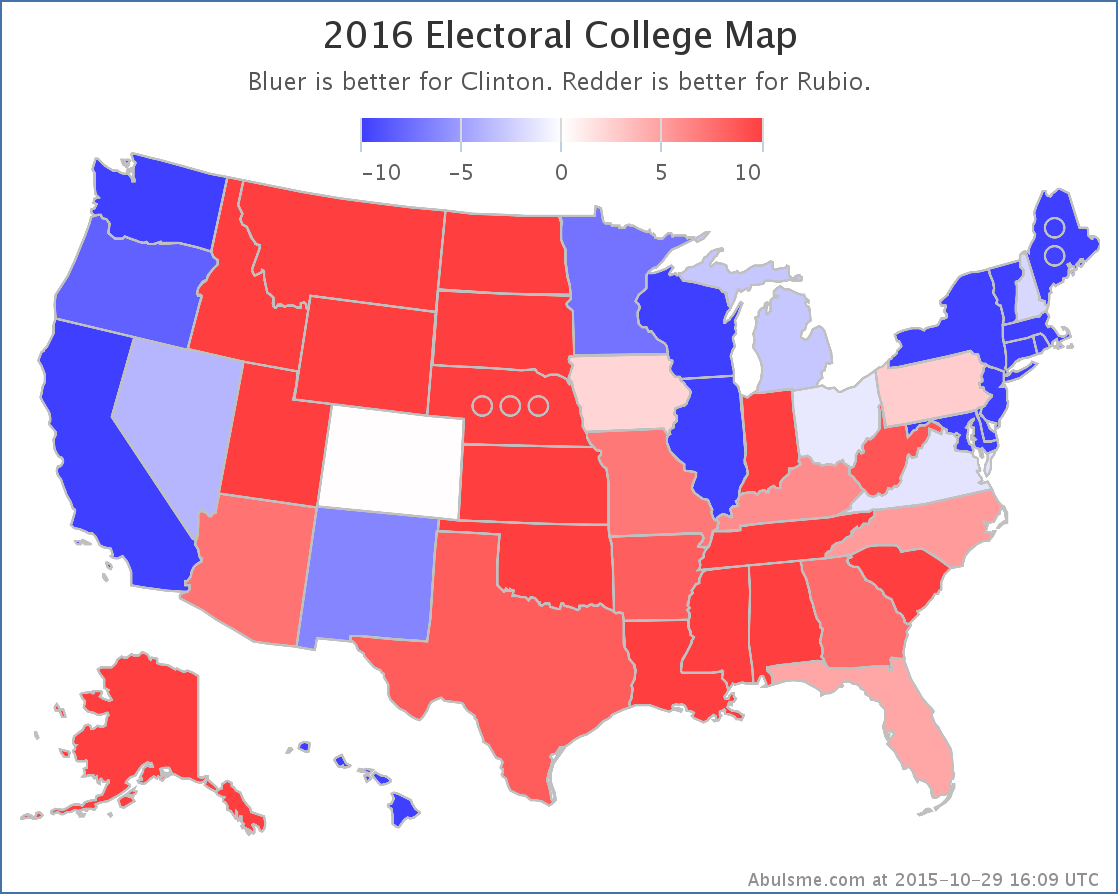
Looks like a lot more red than blue, but a lot of the red states have fewer electoral votes, which is of course why you have to look at the numbers, not just the map.
Going forward, the main question is does Clinton stop her slide and start showing improved performance against Rubio and the other Republicans. With Biden out and Sanders seemingly at a plateau, Clinton can concentrate her efforts on the general election. She seems to be on a roll the last few weeks, turning around her primary poll numbers and for the first time in many months getting a lot of positive press. The unforced self-inflicted errors have not been present for a little while. This has done what it needed to amongst Democrats. I suspect that if Clinton doesn’t do anything to damage herself, and the Republicans continue as they are, we will indeed start to see some of the states that have moved away from Clinton over the past few months start drifting back.
As usual though, actual events may vary.
376.1 days until the general election polls start to close. Stay tuned.
Note: This post is an update based on the data on ElectionGraphs.com. All of the charts and graphs seen here are from that site. Graphs, charts and raw data can be found there for the race nationally and in each state for every candidate combination that has been polled at the state level. In addition, comparisons of the best polled candidate combinations both nationally and each in each state are available. All charts above are clickable to go to the current version of the detail page the chart is from, which may contain more up to date information than the snapshots on this page, which were current as of the time of this post. Follow @ElecCollPolls on Twitter for specific poll details as I add them. And like Election Graphs on Facebook!
As I mentioned yesterday, Christie is seemingly still in the Republican race. There hadn’t been any state level polls that included him since August, but then yesterday there was one in Virginia that improved his position against Clinton. And now in today’s update we have another poll that included him, this time PPP in Pennsylvania, and once again the result is an improvement in Christie’s position vs Clinton.
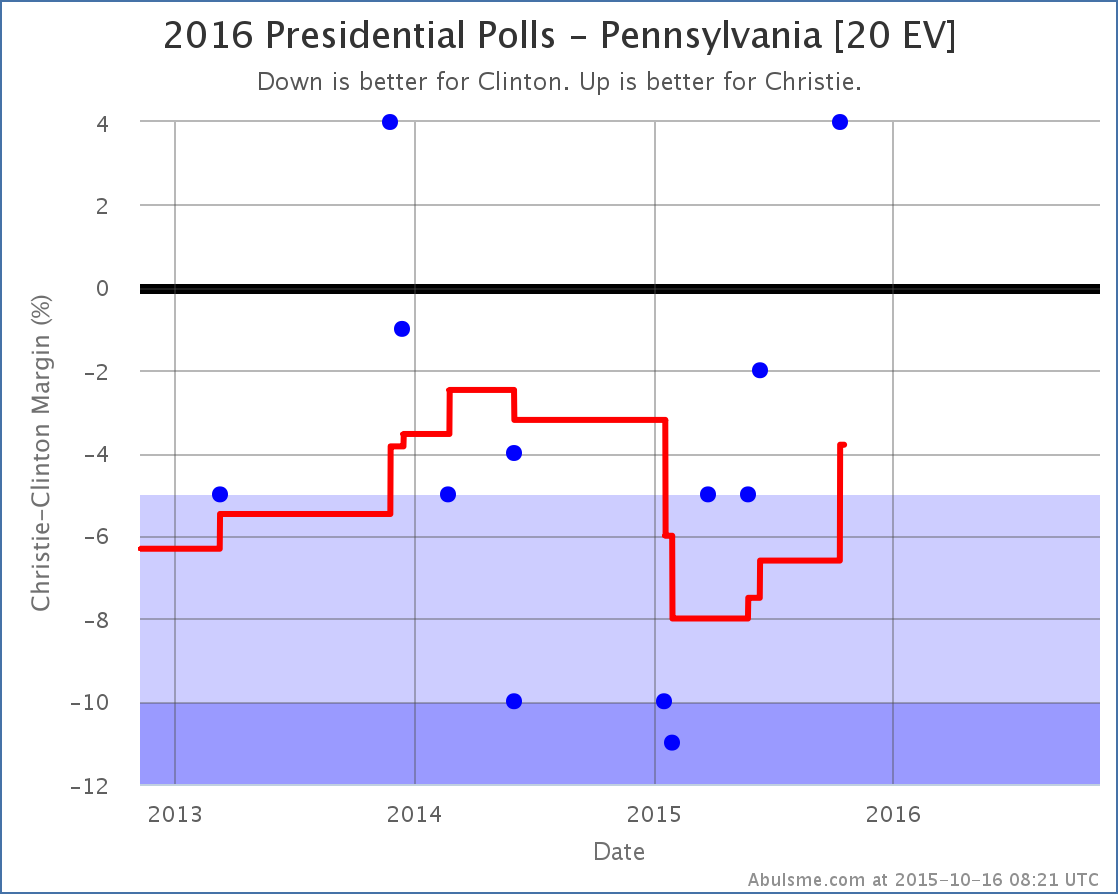
This makes Pennsylvania a possible pickup for Christie and thus improves his “best case” scenario even further.
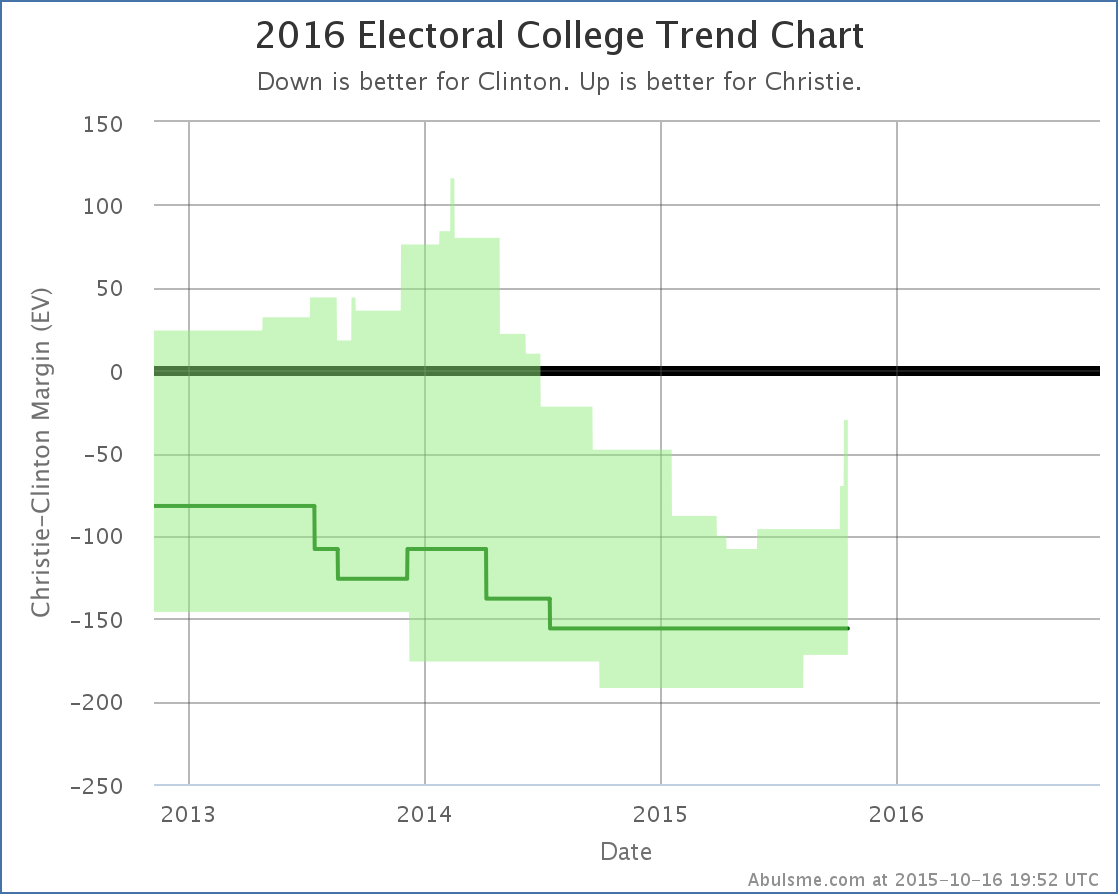
I snarked yesterday about how Christie’s best case was to lose by 70 electoral votes. Well, now his best case is to lose by 30 electoral votes. So he actually is getting a lot closer to being in reach. Of course I also made fun of his 1.9% in the RCP average of national Republican polls… oops, it is 1.7% now.
Clinton vs Christie is still the 5th “best polled” candidate combination according to the metric I use, but I expect that will probably change before too long as we continue to get more and more polls including Trump, Carson, Fiorina and Cruz, with fewer including Christie. Not to mention more with Sanders and Biden. They all seem to have gotten more polling action lately, but not yet enough to bring them into the “top five” I talk about here. There are still significant gaps in close state polling for those candidates, but those are gradually being filled in.
To briefly illustrate why I don’t talk about all the candidate combinations here, the new polling in Pennsylvania from PPP yesterday actually resulted in all of these changes:
Those are all tweets from @ElecCollPolls. That account tweets each and every electoral college related change on ElectionGraphs.com, including each individual poll result as it is added. If you are interested in that level of detail, follow @ElecCollPolls on Twitter.
But be careful interpreting what you see beyond the five best polled combinations I highlight here. There is often still very sparse polling, certainly when compared with the top five, and the averages still rely quite a lot on previous general election results, so it may or may not yet be giving a good picture of where things really stand for that candidate pair. You can still get some insight of course, you just have to be careful.
Here on the blog, I concentrate on the candidate pairs with the most robust polling, and on the changes that impact the range of possible results for those candidates. These “top five” candidate pairs are really where the amount of data available is best and where I can feel the most confident drawing conclusions from the data… and even then you sometimes have to be careful reading too much into things.
After all, it is still 389.1 days until polls start to close. Things will change a lot in those days. Which is why tracking this is fun. Keep watching.
Note: This post is an update based on the data on ElectionGraphs.com. All of the charts and graphs seen here are from that site. Graphs, charts and raw data can be found there for the race nationally and in each state for every candidate combination that has been polled at the state level. In addition, comparisons of the best polled candidate combinations both nationally and each in each state are available. All charts above are clickable to go to the current version of the detail page the chart is from, which may contain more up to date information than the snapshots on this page, which were current as of the time of this post. Follow @ElecCollPolls on Twitter for specific poll details as I add them. And like Election Graphs on Facebook!
Continuing the trend, in today’s update Clinton just weakens further. Let’s just jump right into the details:
Clinton vs Bush
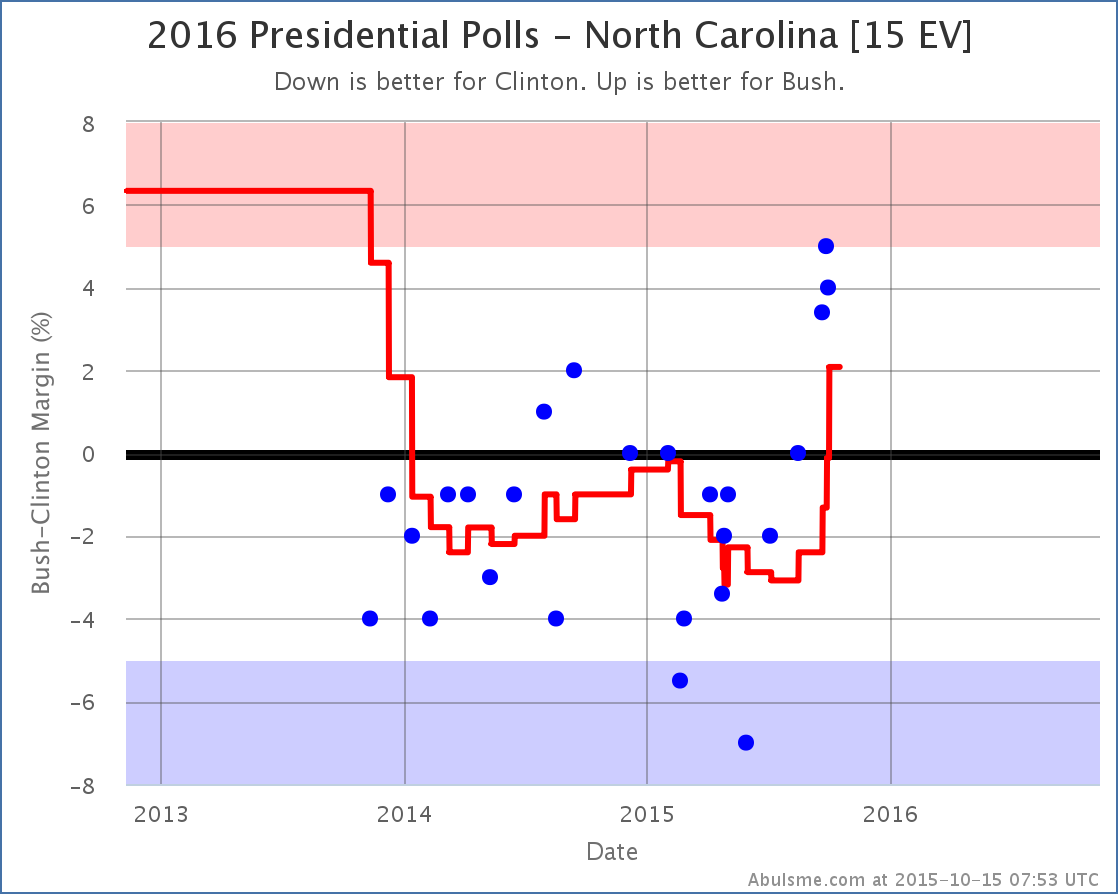
With the latest polls Bush surges to the lead in North Carolina. This has been a pretty quick move. All three polls taken since mid-September have shown a Bush lead. Before that he hadn’t managed better than a tie in North Carolina since September 2014.
This of course improves Bush’s “expected case” where he wins all the states where he leads in my poll average:
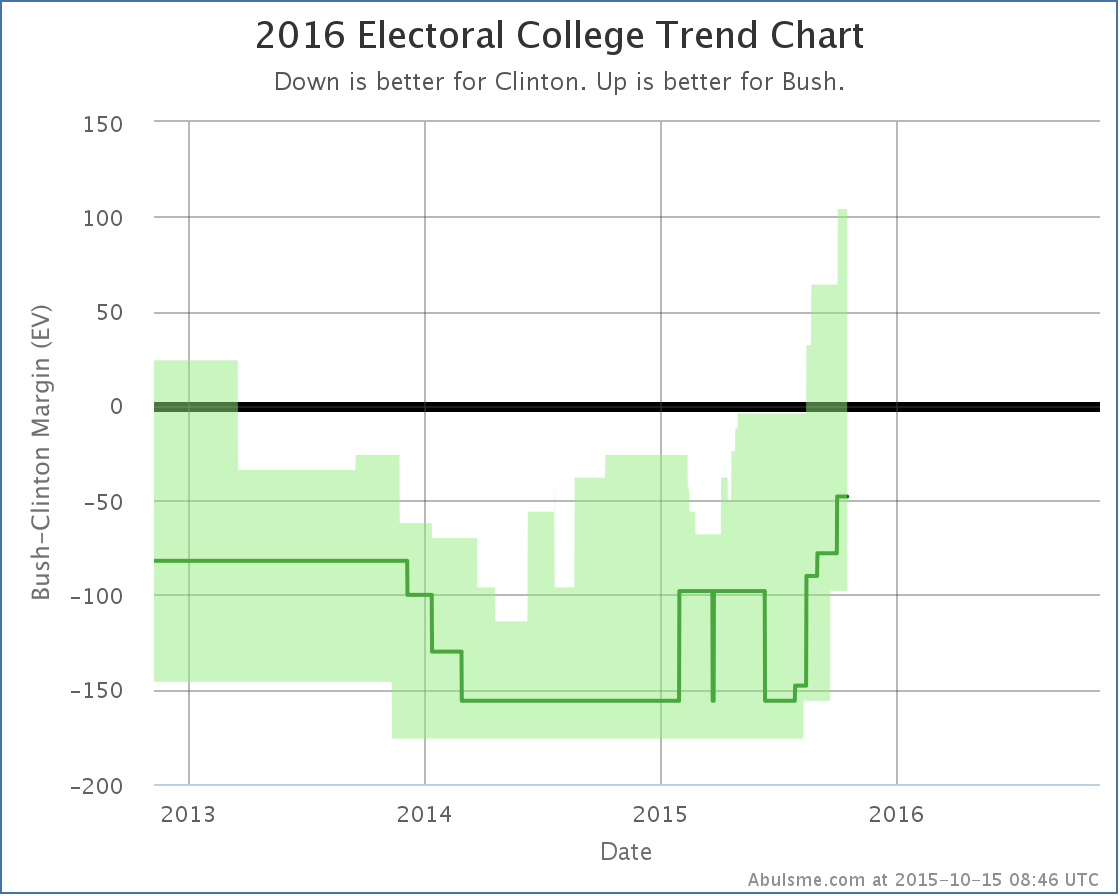
This brings the expected result to Clinton 293 to Bush 245. Still a 48 electoral vote loss for Bush, but that is closer than it has ever been before.
Bush also improved against Clinton in Virginia. This did not result in a category change, but it did move the tipping point further in Bush’s direction:
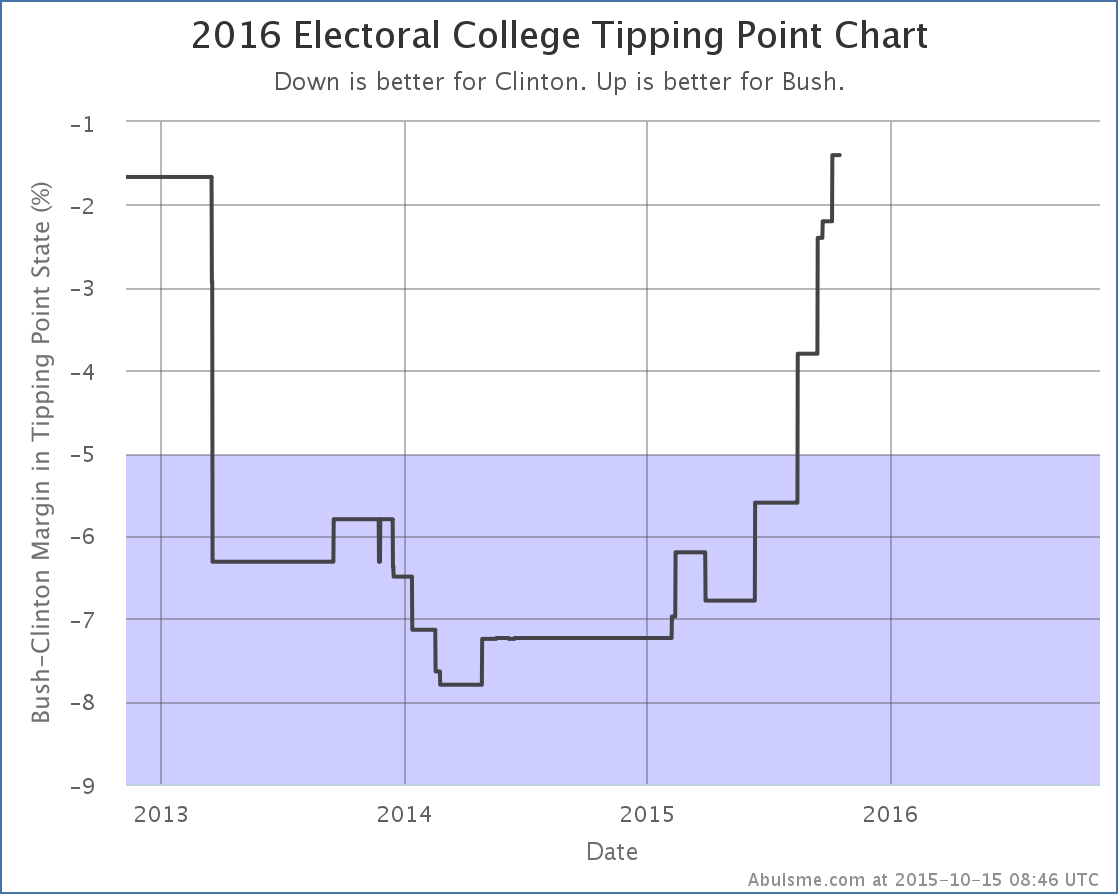
The tipping point is now 1.4% in Michigan in Clinton’s favor. So a national poll move of as little as 0.7% would flip the electoral college to Bush’s side. Bush may not be leading yet like Rubio is, but he is actually very close to that. His best case is to win by 104 electoral votes if he gets all the close states. So Bush is certainly competitive with Clinton at the moment.
Bush vs Christie
Christie? Is he still running? I thought he was just about gone. Before today’s update, nobody had bothered to include Christie in a state level poll since late August. More than a month. But CNU decided to include him in a new Virginia poll, and it improved his position in Virginia:
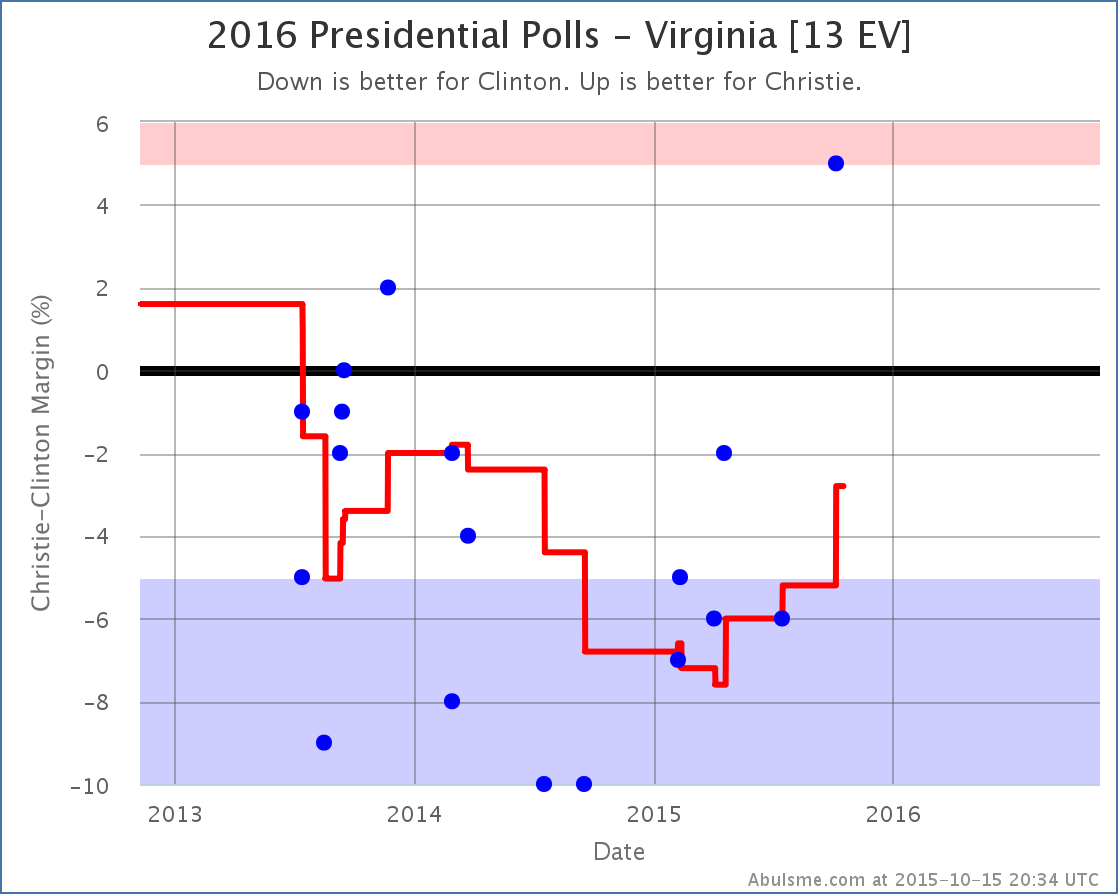
This drops Clinton’s lead against Christie in Virginia to only 2.8%, making the state once again a “swing state” that could go either way.
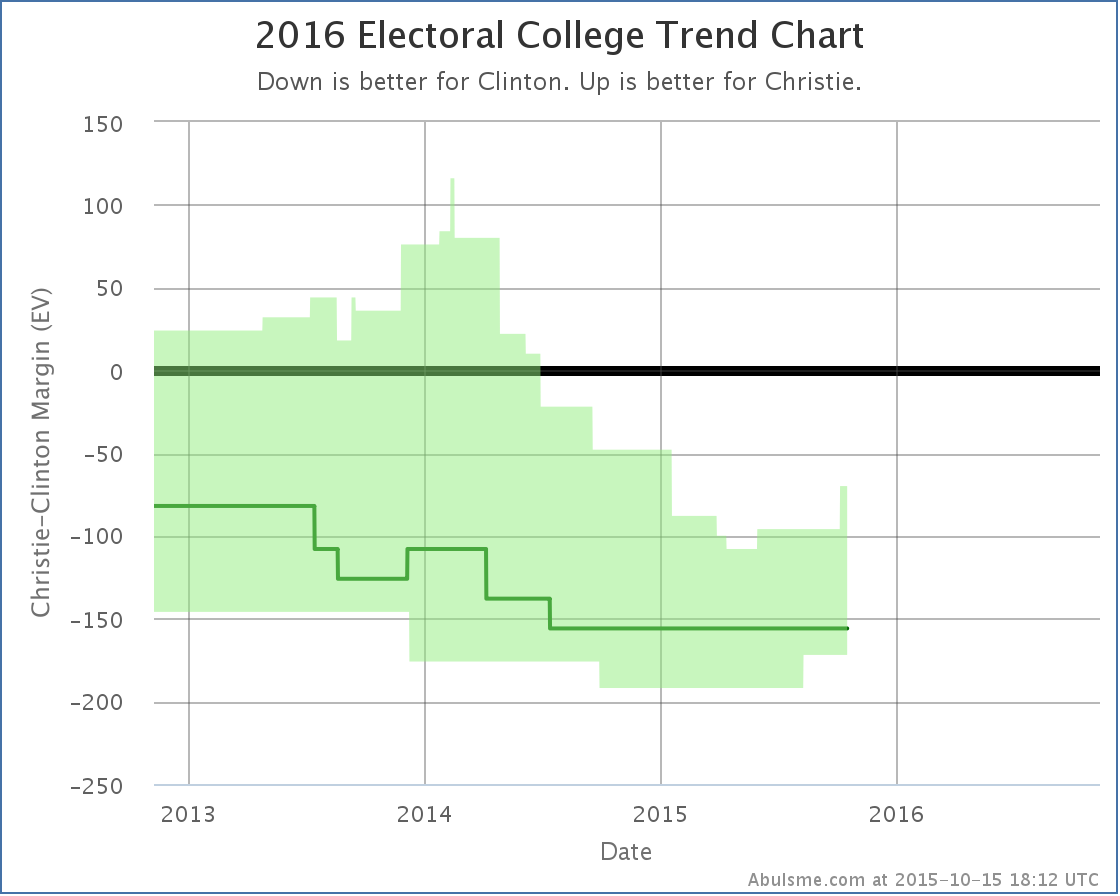
Christie’s best case, if he wins all of the close states, is now to lose by 70 electoral votes. His expected case is still to lose by 156 electoral votes. Unlike Bush, Christie is not competitive with Clinton at the moment. Things can change quickly though, so you never know! But with Christie at 1.9% in the RCP average of national Republican polls, I’m not sure if Christie will have a chance to find out.
390.1 days until the polls start to close!
Note: This post is an update based on the data on ElectionGraphs.com. All of the charts and graphs seen here are from that site. Graphs, charts and raw data can be found there for the race nationally and in each state for every candidate combination that has been polled at the state level. In addition, comparisons of the best polled candidate combinations both nationally and each in each state are available. All charts above are clickable to go to the current version of the detail page the chart is from, which may contain more up to date information than the snapshots on this page, which were current as of the time of this post. Follow @ElecCollPolls on Twitter for specific poll details as I add them. And like Election Graphs on Facebook!
This is probably the most significant update I’ve posted since launching this analysis in November. For the first time, one of the Republicans with significant amounts of polling is actually leading Clinton. Specifically, in Clinton vs Rubio, the “expected result” where each candidate wins all the states where they currently lead in my polling average, is now Clinton 268 to Rubio 270. That is a narrow win, but that is a win.
Since the spring, almost every update has been bad news for Clinton, but the collapse here has been more rapid than that. As recently as July, Clinton was leading Rubio by 156 electoral votes in my analysis. In less than three months, this lead completely evaporated. It is a long way until the election still. And some deterioration was expected. But this trend for Clinton is dramatic. Has she reached the bottom yet? Absent additional major negative revelations, she must be close to a floor… but there is no slowing of this trend visible yet. Things just get worse and worse for Clinton. (At least vs Rubio and Bush… for other opponents, either the trend is less dramatic, or there is just not enough recent state level polling data to draw good conclusions yet.)
Clinton vs Rubio
Lets look into the details. First of all, Pennsylvania:
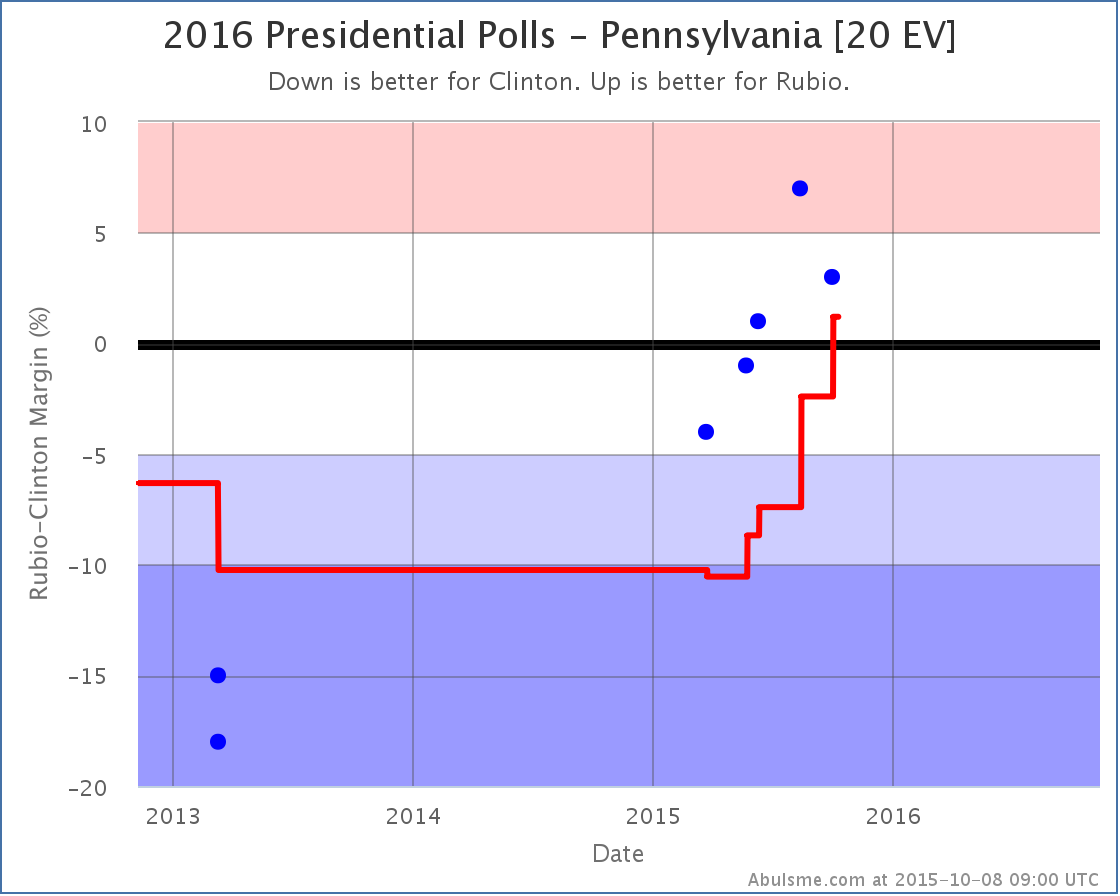
Pennsylvania has not been as heavily polled as some other states, the poll average still covers 6.6 months, but the trend here resembles the trend in many other states, with Clinton losing ground with almost every poll. With this last poll, the average was pulled over to Rubio’s side of the center line. Pennsylvania’s 20 electoral votes was enough to make Rubio the overall winner. This was the big change that caused today’s headline.
Between Pennsylvania’s move, and a smaller move in Ohio that didn’t cross category lines, the tipping point of course moved too:
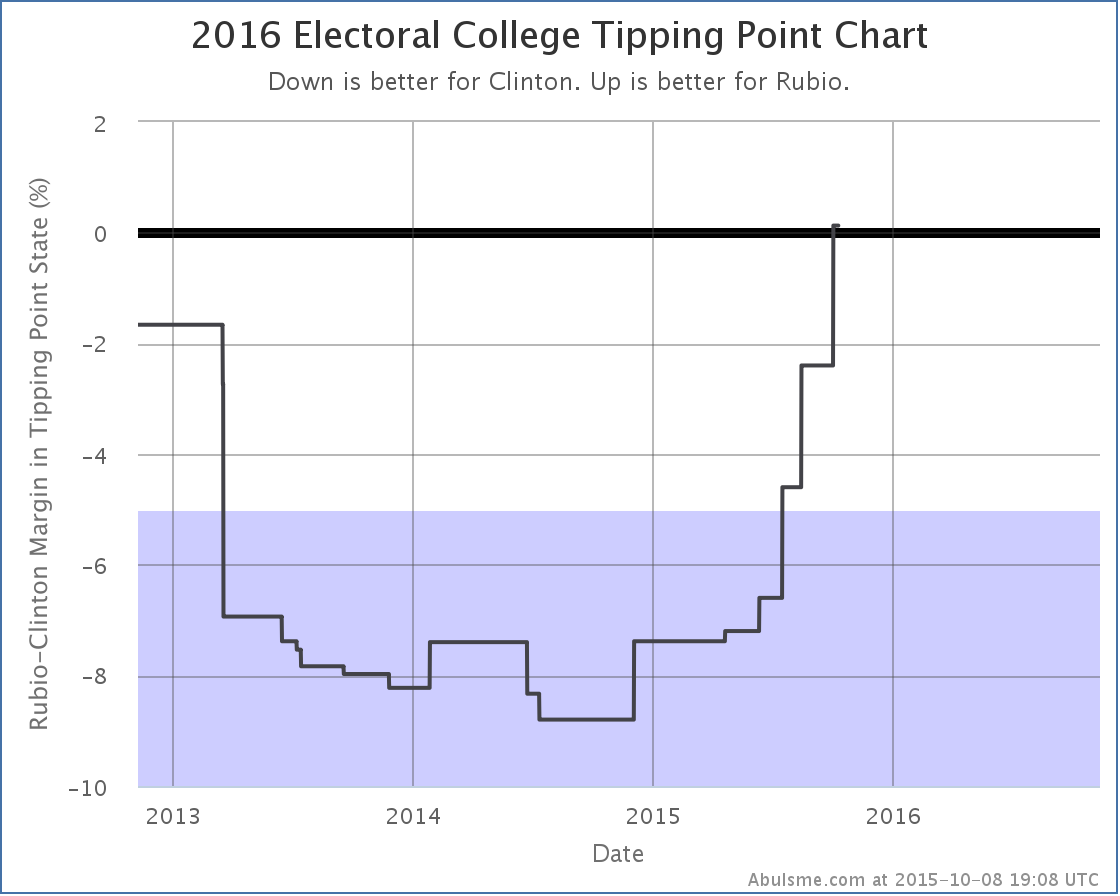
A year ago the tipping point was at 8.8% in Clinton’s favor. It is now Rubio by 0.1%. That is a razor thin margin, but it is a Rubio win.
Which brings us to the fact that there actually was one positive thing for Clinton in the latest Clinton vs Rubio results. Florida.
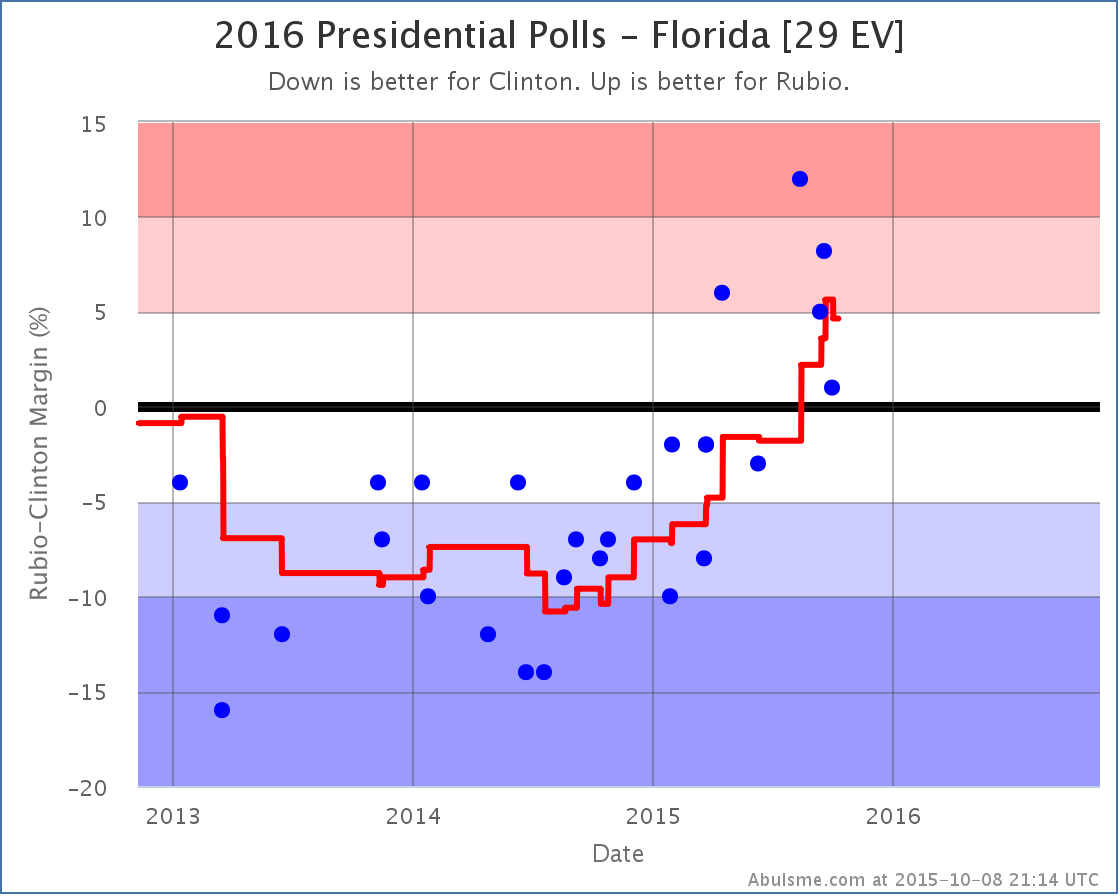
The poll average in Florida actually moves a little toward Clinton with the latest poll, bringing it to a 4.6% Rubio lead. This once again puts Florida in the “could go either way” category based on my classifications, and so improves Clinton’s best case.
With all of these changes, here is the new “bubble”:
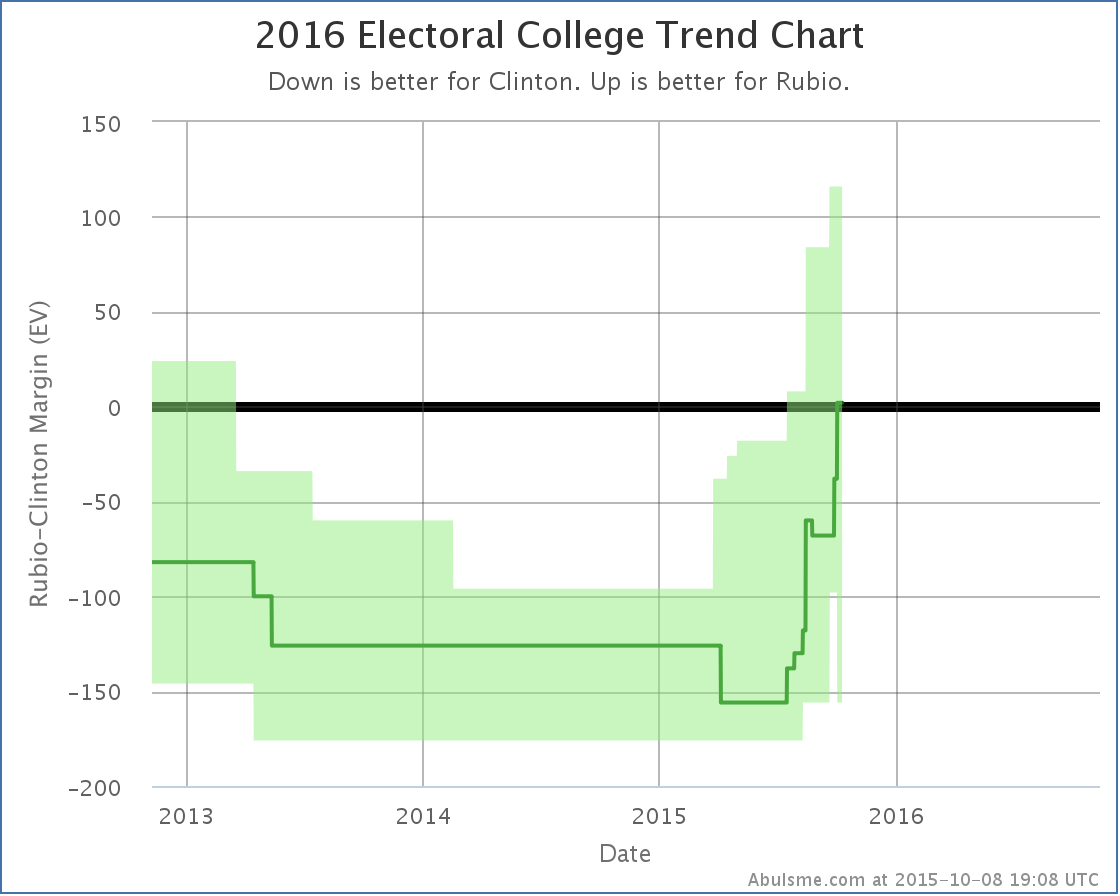
One of the most surprising things about this chart, especially compared to how things looked a year ago, is just the height of that bubble… the range of possible outcomes that are reasonable given the current state of polling. Right now the summary looks like this:
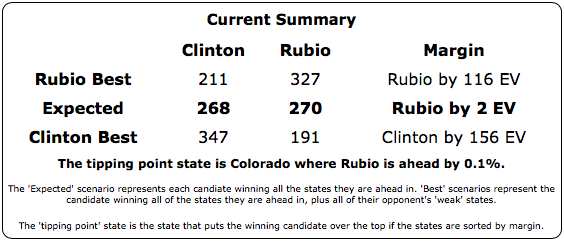
And the state spectrum:

There are now TEN states where the polling is close. 136 electoral votes. Everything from Clinton winning by 156 to Rubio winning by 116 is plausible given only minor moves in the polls. This is a huge range of possible outcomes here.
Right now, the tipping point is right smack in the middle of those states, five on each side of the line… with a margin in the tipping point state of only 0.1% and Rubio ahead by only TWO electoral votes. The only way this could be closer is if we were actually looking at a 269-269 tie.
Right now, 13 months from the election, Clinton vs Rubio is as close to an even race as you could possibly imagine. But with the huge number of close states, it is “close” in the sense of too close to call, but we can’t rule out the possibilities of either candidate winning by a significant margin! There are just too many states that could go either way. (Having said that, results closer to the middle of the range are indeed more likely than those at the edges. Having ALL the close states go to one candidate or the other is extremely unlikely.)
A lot can and will happen in the next year… it is certainly possible that neither of these two candidates end up as the nominees. But this can’t be where Clinton hoped to be at this point. She wanted to be seen as not just inevitable for the Democratic nomination, but with a very healthy lead in the general election.
That is not what is happening.
The question now is if Rubio is able to start strengthening this into a clear lead, instead of just a toss up. Can he start flipping Ohio? New Hampshire? Michigan? If current trends continue, it would not be surprising…
Clinton vs Bush
Although the big news was in Clinton vs Rubio, there was also a change in Clinton vs Bush. It also favored the Republican.
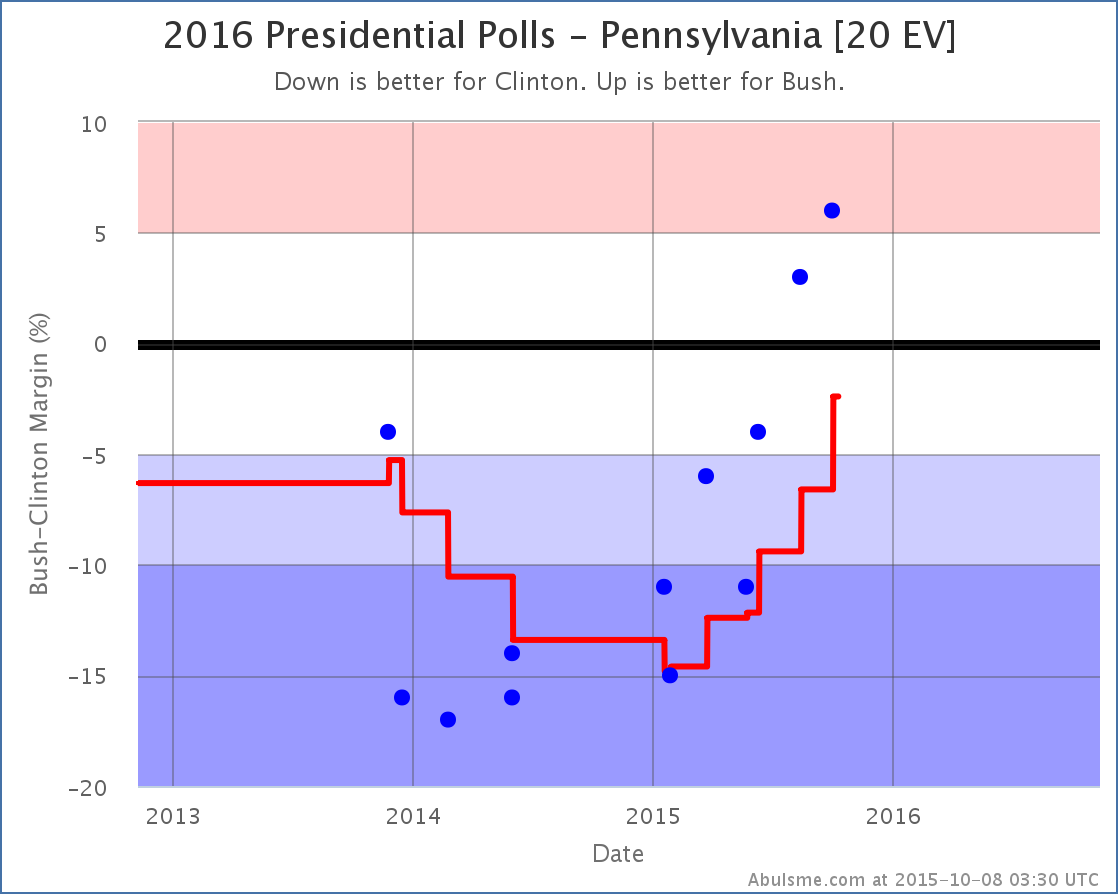
Bush is a bit behind Rubio in his Pennsylvania polling against Clinton, but it has also been consistently improving for months. With today’s new poll, Clinton’s lead drops to 2.4%, putting Pennsylvania in the swing state category, and improving Bush’s best case.
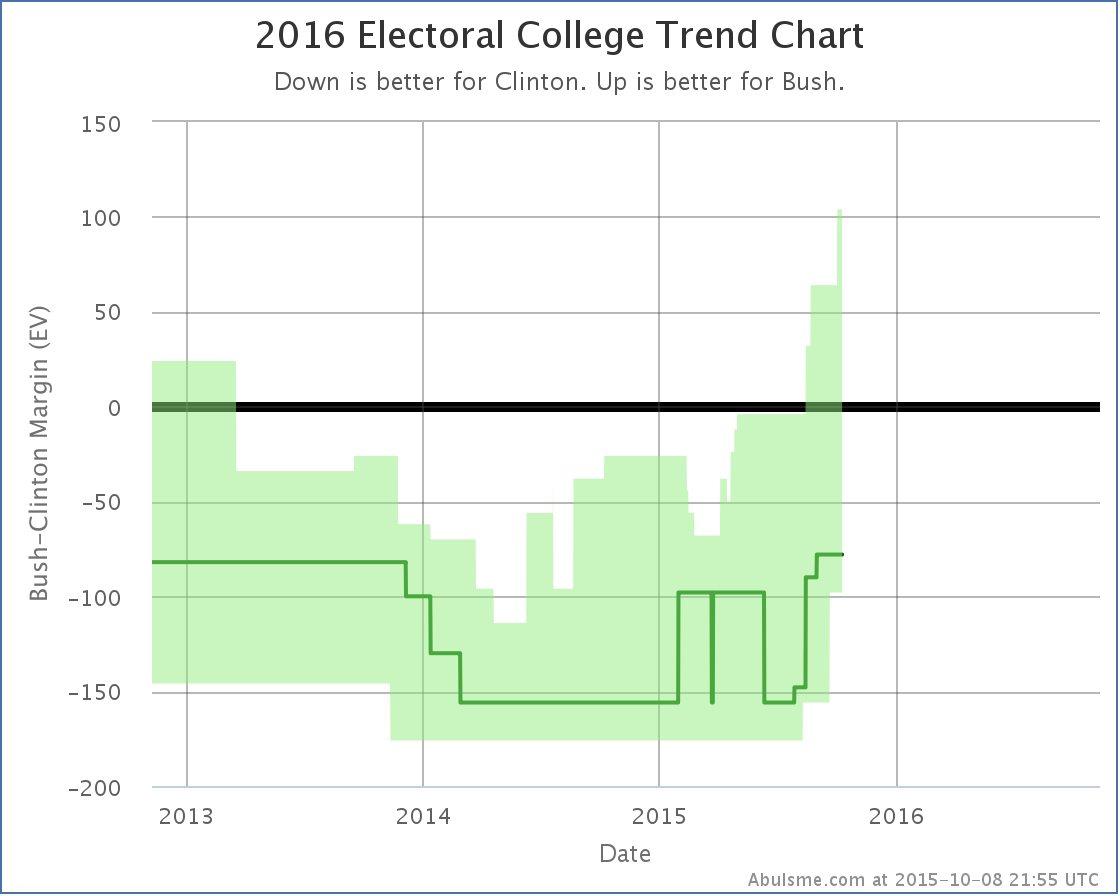
Pennsylvania moving into the realm of the possible is that spike in the upper right. Bush’s best case is now to win by 104 electoral votes. The range of possibilities isn’t quite as wide as with Rubio, but at 101 electoral votes in play, it is still pretty wide.
None of this is a prediction of what will happen in November 2016. We are still too far away for that. It is just a snapshot of where we are today.
397.1 days until polls start to close. A lot of drama yet to come in those days.
Note: This post is an update based on the data on ElectionGraphs.com. All of the charts and graphs seen here are from that site. Graphs, charts and raw data can be found there for the race nationally and in each state for every candidate combination that has been polled at the state level. In addition, comparisons of the best polled candidate combinations both nationally and each in each state are available. All charts above are clickable to go to the current version of the detail page the chart is from, which may contain more up to date information than the snapshots on this page, which were current as of the time of this post. Follow @ElecCollPolls on Twitter for specific poll details as I add them. And like Election Graphs on Facebook!
Another day, another state moving away from Clinton. This time it is Florida moving toward Bush:
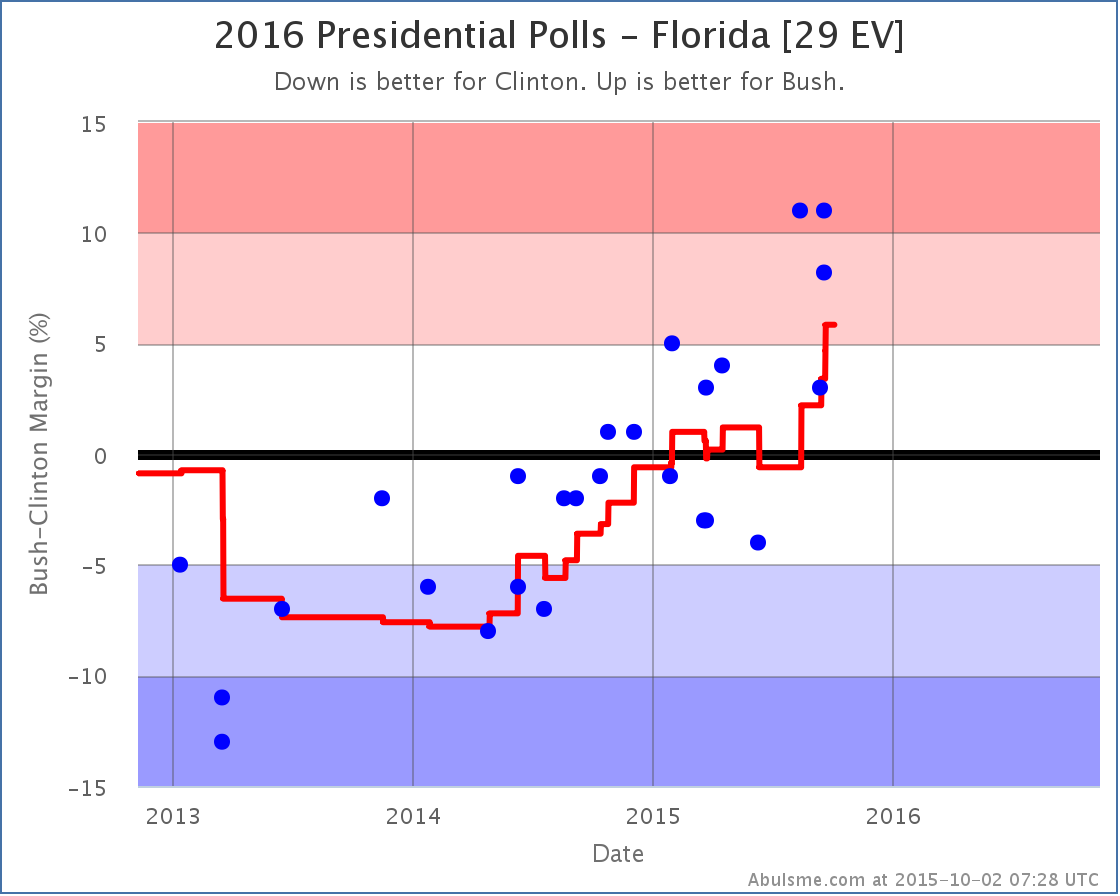
In a pattern remarkably similar to Rubio’s, Bush has consistently been improving against Clinton in Florida for over a year. After a bit of a pause for a few months, that trend has now accelerated. As of the last poll the average goes to Bush +5.8%. This takes Florida out of the “close” category and out of what I consider to be Clinton’s “best case”.
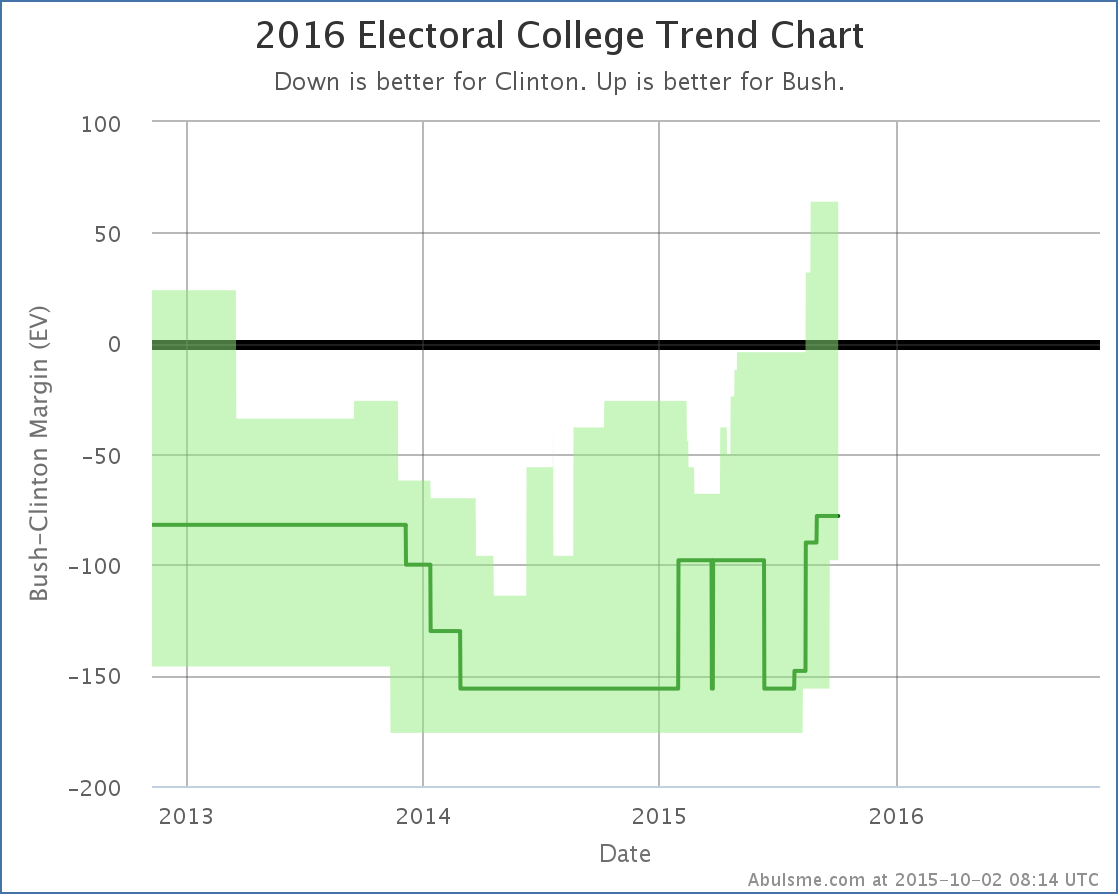
Florida slipping out of Clinton’s reach is that notch in the bottom right of the “bubble” above. Clinton’s best case is now worse for her than her WORST case was back in June 2014. Although I predicted back in November that Clinton was probably at her high water mark and would fall from there, the degree of the fall has been dramatic. The open question is of course, “When does the bleeding stop?”. Right now Clinton is still ahead, although it is much closer than it once looked. But she is only a state or two away from actually being behind. (At least against Bush and Rubio.)
403.4 days until polls start to close on Election 2016.
Note: This post is an update based on the data on ElectionGraphs.com. All of the charts and graphs seen here are from that site. Graphs, charts and raw data can be found there for the race nationally and in each state for every candidate combination that has been polled at the state level. In addition, comparisons of the best polled candidate combinations both nationally and each in each state are available. All charts above are clickable to go to the current version of the detail page the chart is from, which may contain more up to date information than the snapshots on this page, which were current as of the time of this post. Follow @ElecCollPolls on Twitter for specific poll details as I add them.
It is getting boring to keep saying “Republican getting stronger against Clinton”, but it is time for yet another update saying just that. As has been common lately, the Republican in question is Rubio, so lets look at these moves:
North Carolina
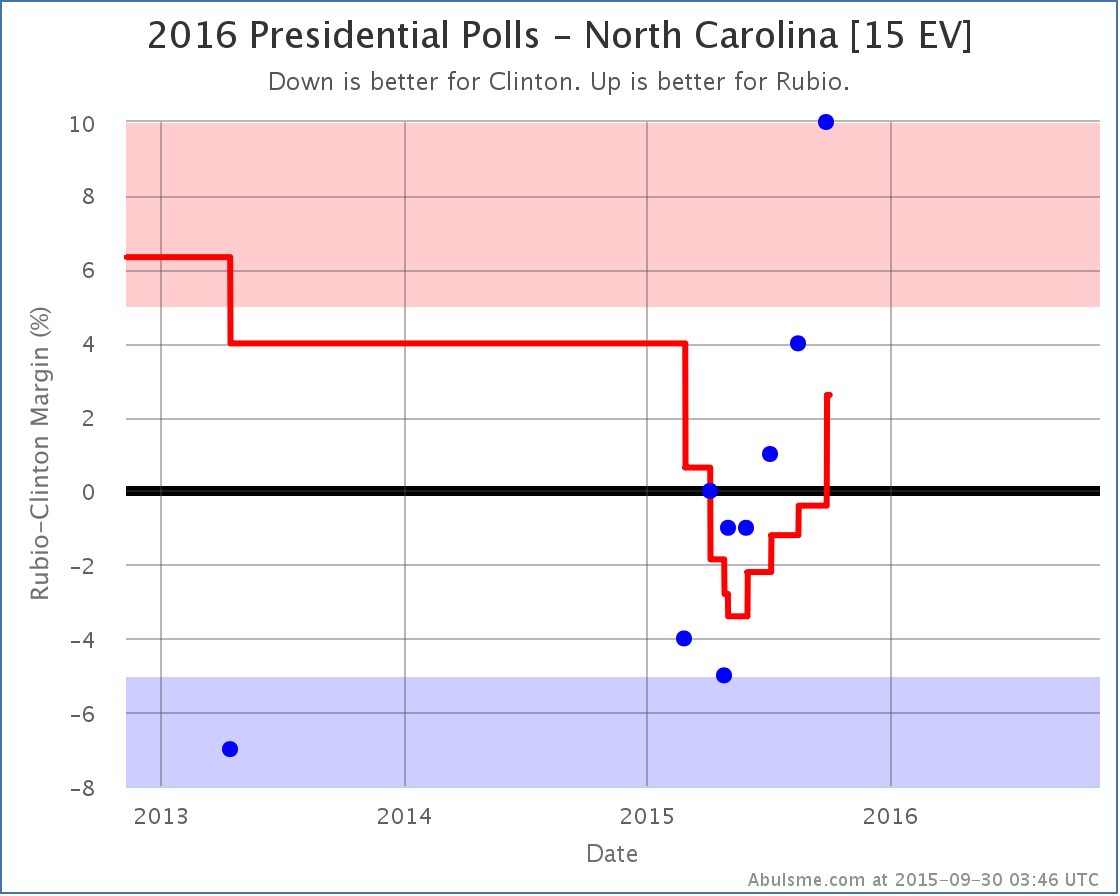
Look at that trend! It just gets worse and worse for Clinton. Every new poll in the last few months has been worse than the poll before. And with the latest, the average flips to Rubio’s side of the line.
North Carolina was never going to be a blow out for Clinton, but it was looking for awhile that she was in a good position to pull out a narrow win. That possibility seems to be evaporating quickly.
Michigan
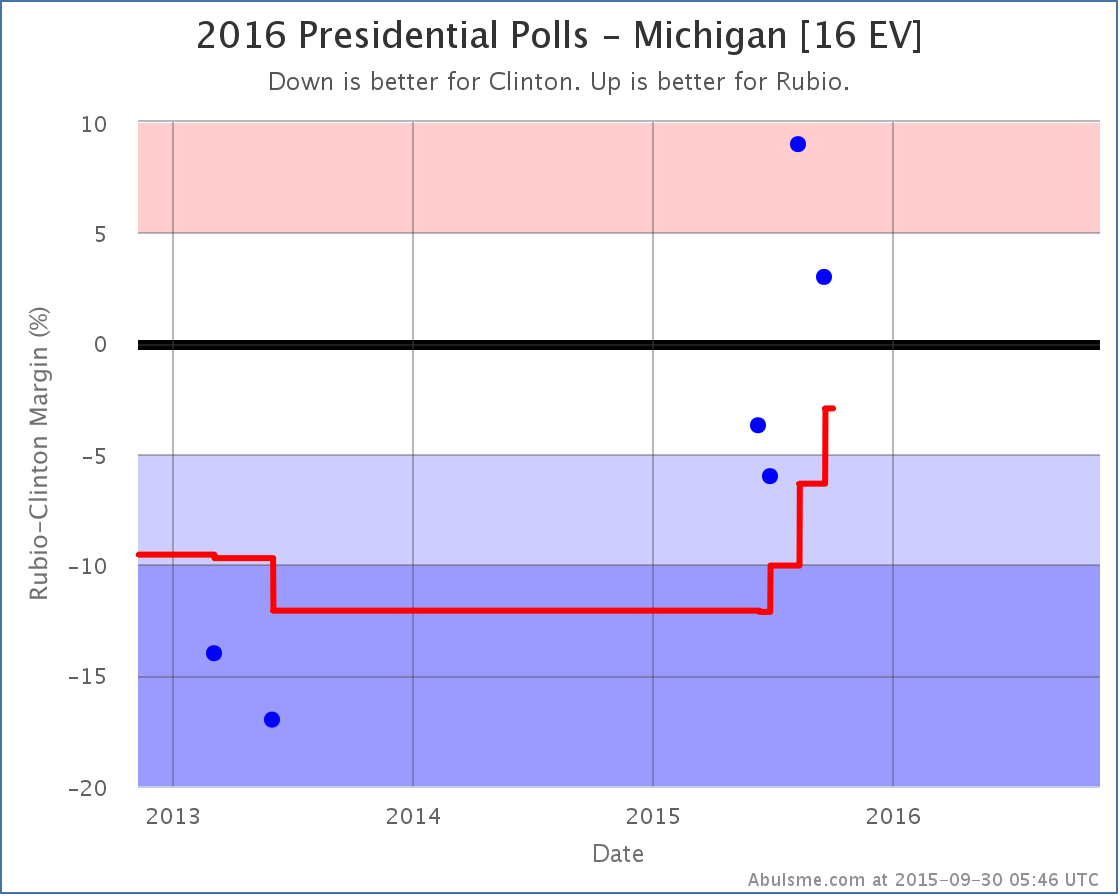
There are less polls to back it up, but the move in Michigan is potentially more dramatic. In a few months the average has gone from a strong Clinton lead, to Michigan essentially being a toss up.
Once again, not a good trend for Clinton. Michigan has not gone Republican since voting for George HW Bush in 1988. In 5 of those 6 elections the winning margin for the Democrats was over 5%. In two of them it was over 10%. A close Michigan means a Clinton in trouble.
National Overview
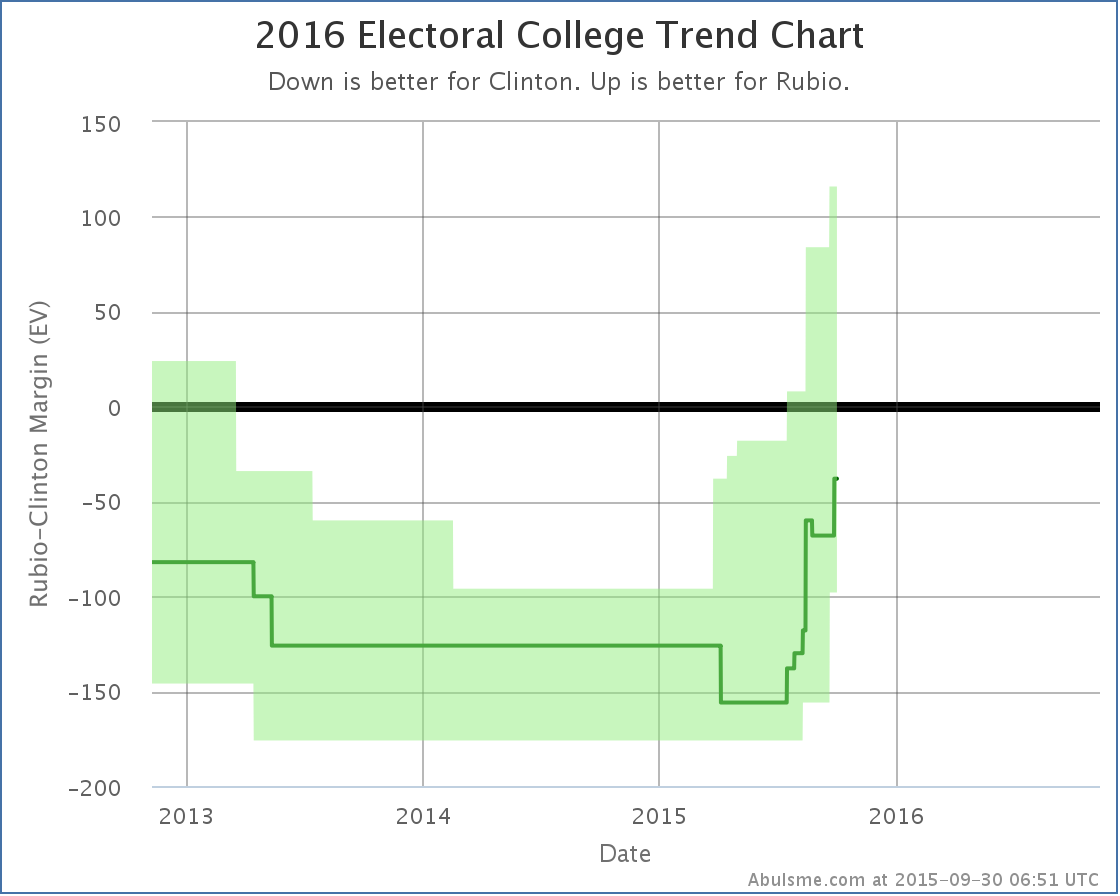

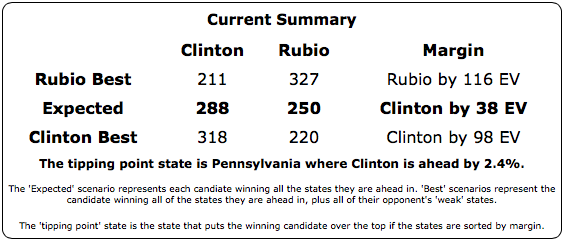
Yes, if everybody wins the states where they are leading in my poll average, Clinton still wins… barely. But there are a HUGE number of states where it is close. In this matchup, nine states are in play and the range of possible outcomes is very wide. Right now Rubio’s best case (if he sweeps all the close states) is actually better than Clinton’s best case (if she sweeps the close states).
Clinton still has an advantage here, but just by the slimmest of margins. There is a long way to the election, but for the moment, at least in the Clinton vs Rubio matchup, this is a close race…
Other Candidates
So Rubio is doing well against Clinton, and that is the only one of the five best polled candidate combinations with a change today, but a quick look at the comparison is still useful.
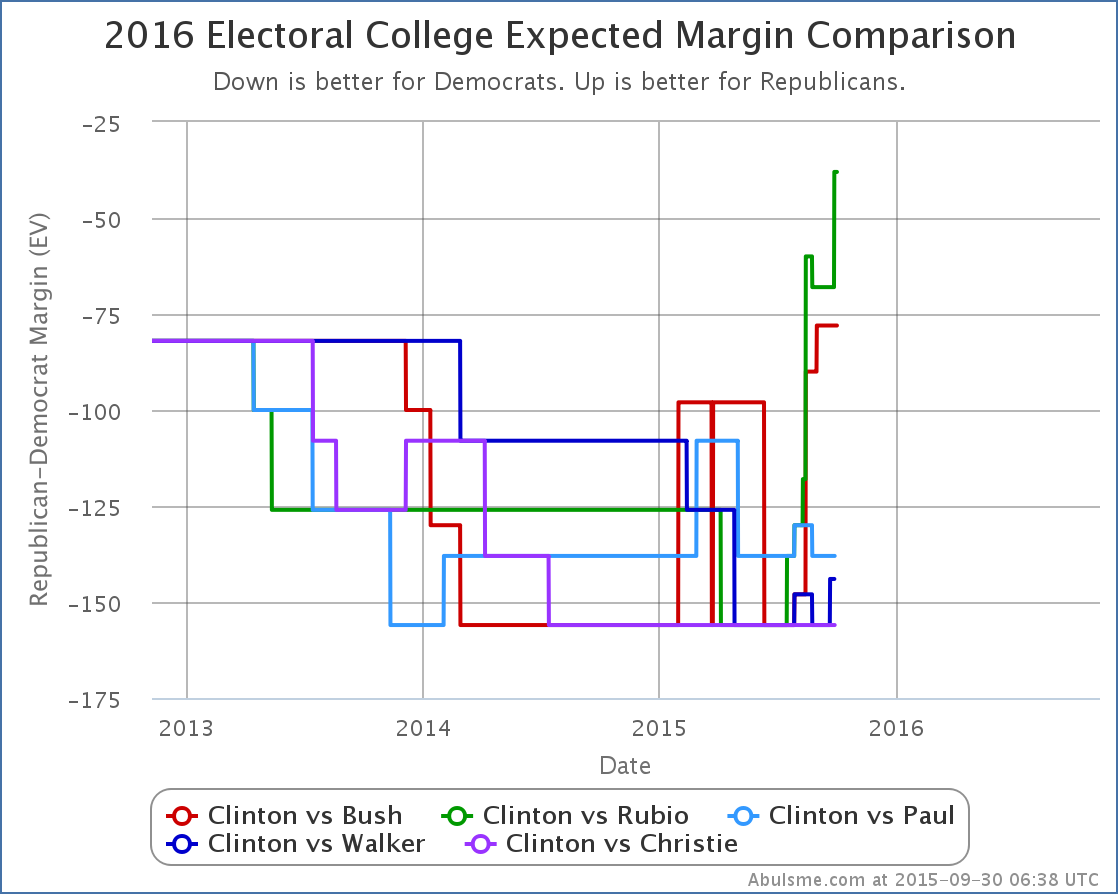
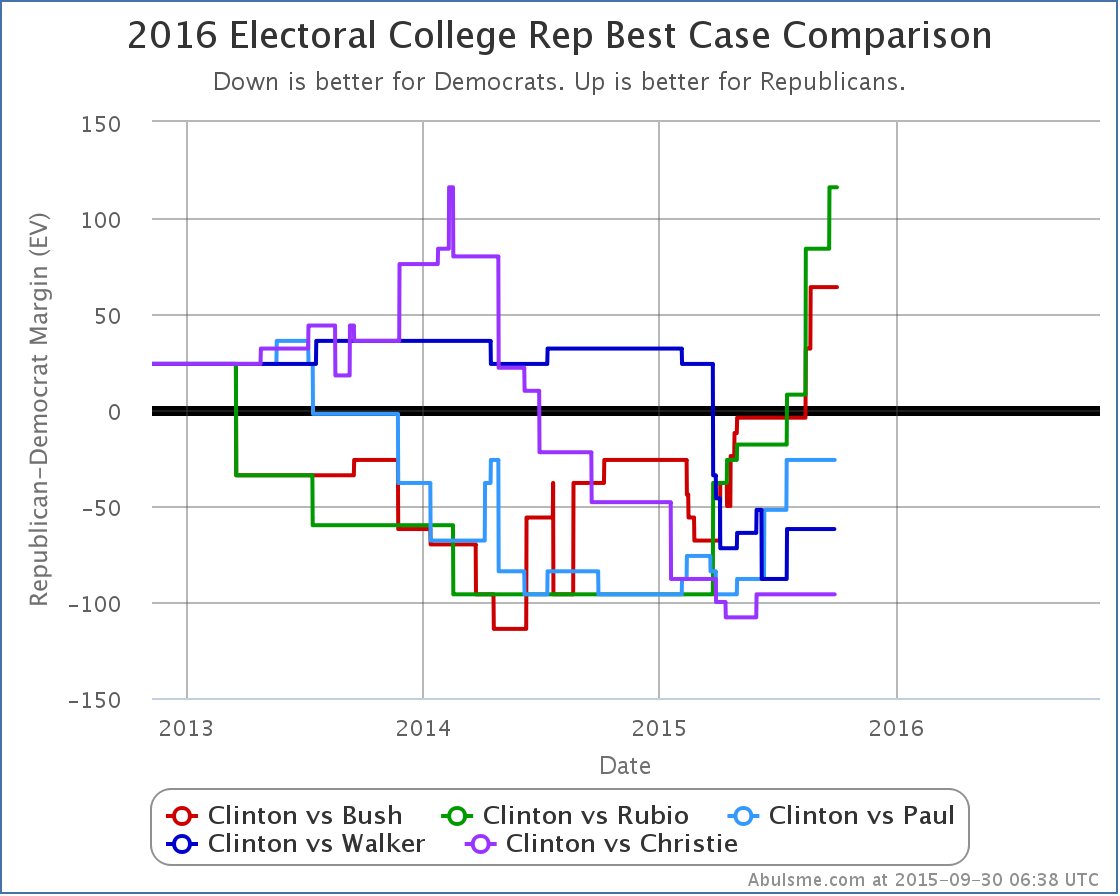
Highlighting these two comparisons specifically because of the Rubio changes today, but similar trends show up for the other comparisons. Of the five best polled combinations, Bush and Rubio are standing out and have been dramatically improving their positions vs Clinton. Paul, Walker and Christie… have not. At least not lately. Of course, Walker has already dropped out at this point, and Christie and Paul are on life support, with their national Real Clear Politics polling averages at 3% or less right now. So they just aren’t getting the attention… or the polling volume lately… of Bush and Rubio.
As I’ve mentioned before, other candidates are getting a lot more attention now, but they are still way behind these five in the arbitrary polling quality metric I use. They just haven’t had enough sustained polling to get a comparable picture yet. That will change if the folks like Trump and Carson and Fiorina remain viable and folks like Paul, Walker and Christie fade away. Same thing for Sanders and Biden. It just takes a bit of time to get enough good state polls to start paying serious attention to the results in an analysis like this.
405.1 days until polls start to close.
Note: This post is an update based on the data on ElectionGraphs.com. All of the charts and graphs seen here are from that site. Graphs, charts and raw data can be found there for the race nationally and in each state for every candidate combination that has been polled at the state level. In addition, comparisons of the best polled candidate combinations both nationally and each in each state are available. All charts above are clickable to go to the current version of the detail page the chart is from, which may contain more up to date information than the snapshots on this page, which were current as of the time of this post. Follow @ElecCollPolls on Twitter for specific poll details as I add them.
Aside from that one blip of good news in August every single update I’ve posted in many months has been more bad news for Clinton. This update is no exception, with two changes worth noting, both in favor of the Republican.
Clinton vs Bush
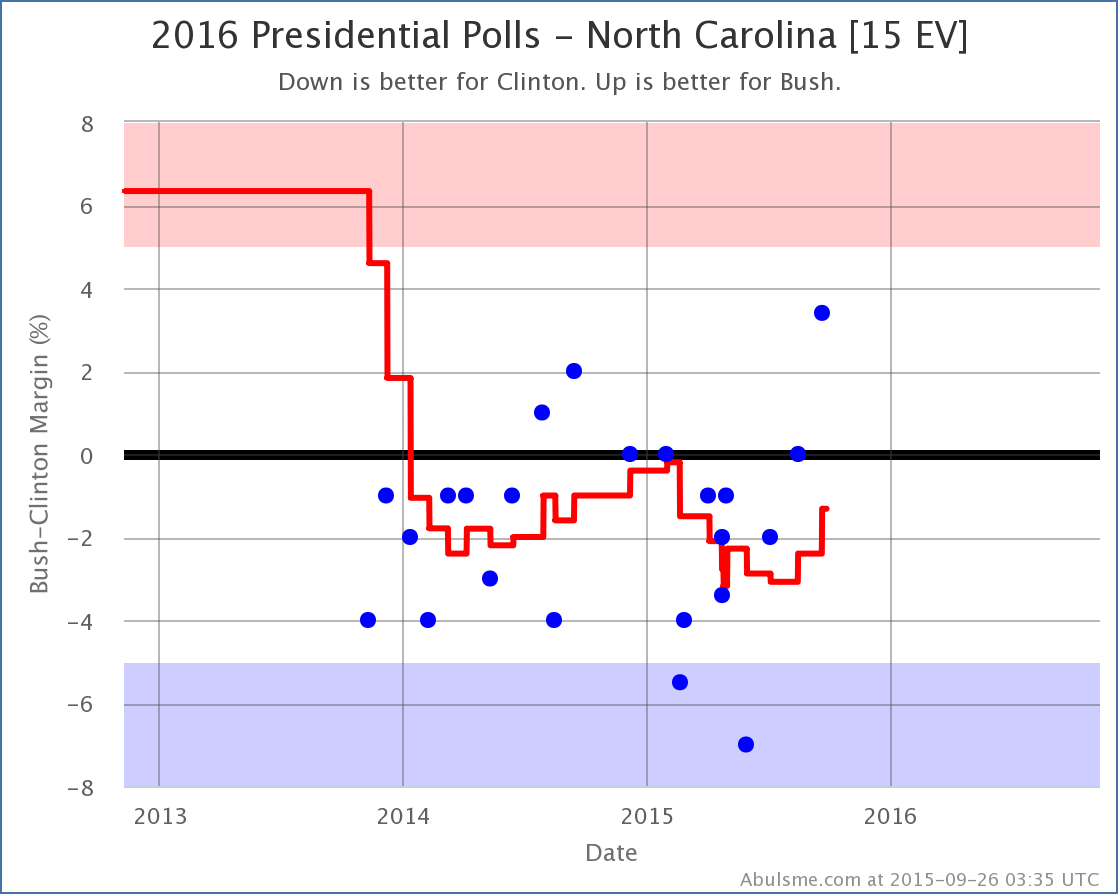
The new poll in North Carolina didn’t shift move the state to a new category, but the move from a Clinton lead of 2.4% down to a Clinton lead of 1.3% moved the tipping point, which had been North Carolina. With North Carolina shifting Bushward, the tipping point becomes Colorado, where Clinton is ahead by 2.2%.
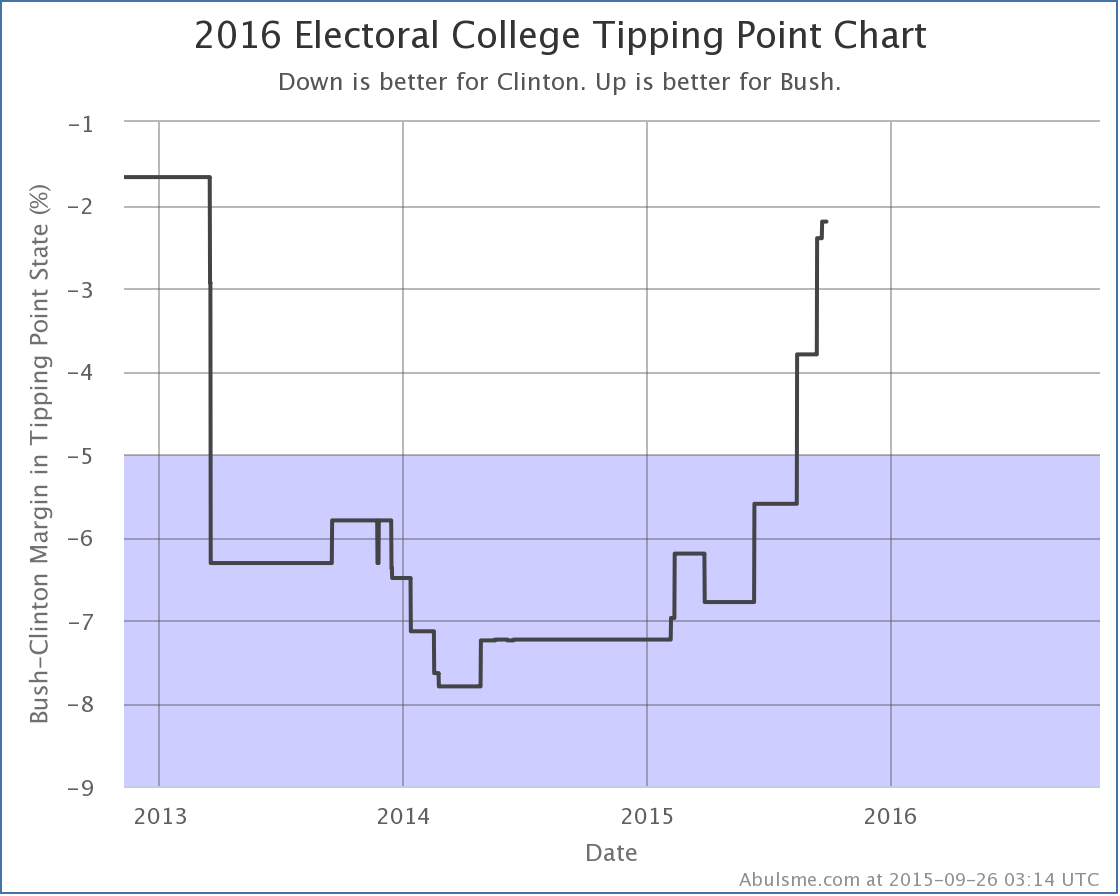
This is a relatively small blip upward for the tipping point, but it continues the trend. This race just keeps getting closer. Remember, the tipping point is how far polls have to move nation wide in order to flip the result of the election. The gap is now only 2.2%. That is tiny. A 2.2% lead can disappear over night, or be an illusion cased by a bias in the polls. Right now, Bush and Clinton are effectively neck and neck. Yes, Clinton has a lead, but it is extremely narrow.
The spectrum of the states now looks like this:

Clinton’s buffer is down to just Colorado, Michigan and North Carolina, all states where her lead is less than 2.2%. We’re only a few Republican leaning polls in those three states away from having a Republican in the lead for the first time since I launched this site.
Clinton vs Walker
Well, he dropped out. But a poll in Iowa that included him wrapped up just before his announcement. And that poll was good for Walker. So, one last hurrah…
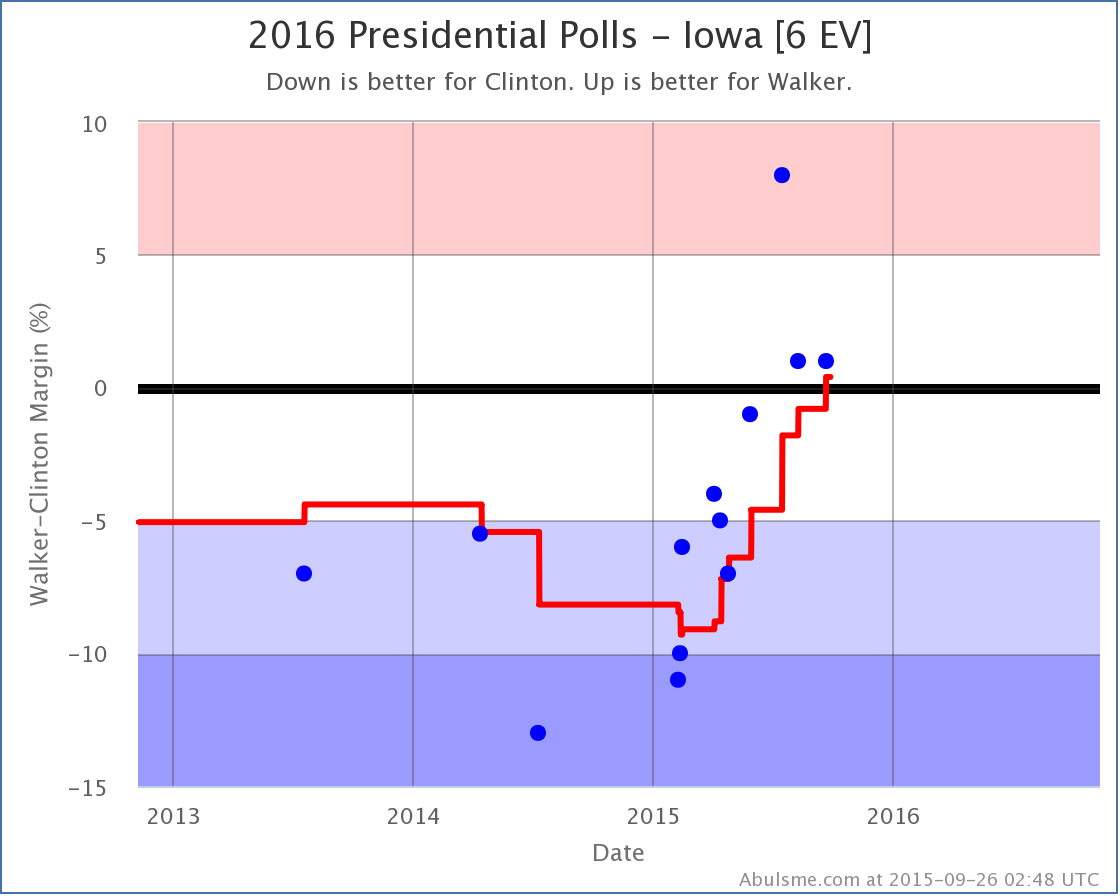
With this last poll… and it will be surprising if there are any more with Walker… Walker takes a narrow lead vs Clinton, and so moved Iowa into his column, increasing his “expected” result against Clinton…
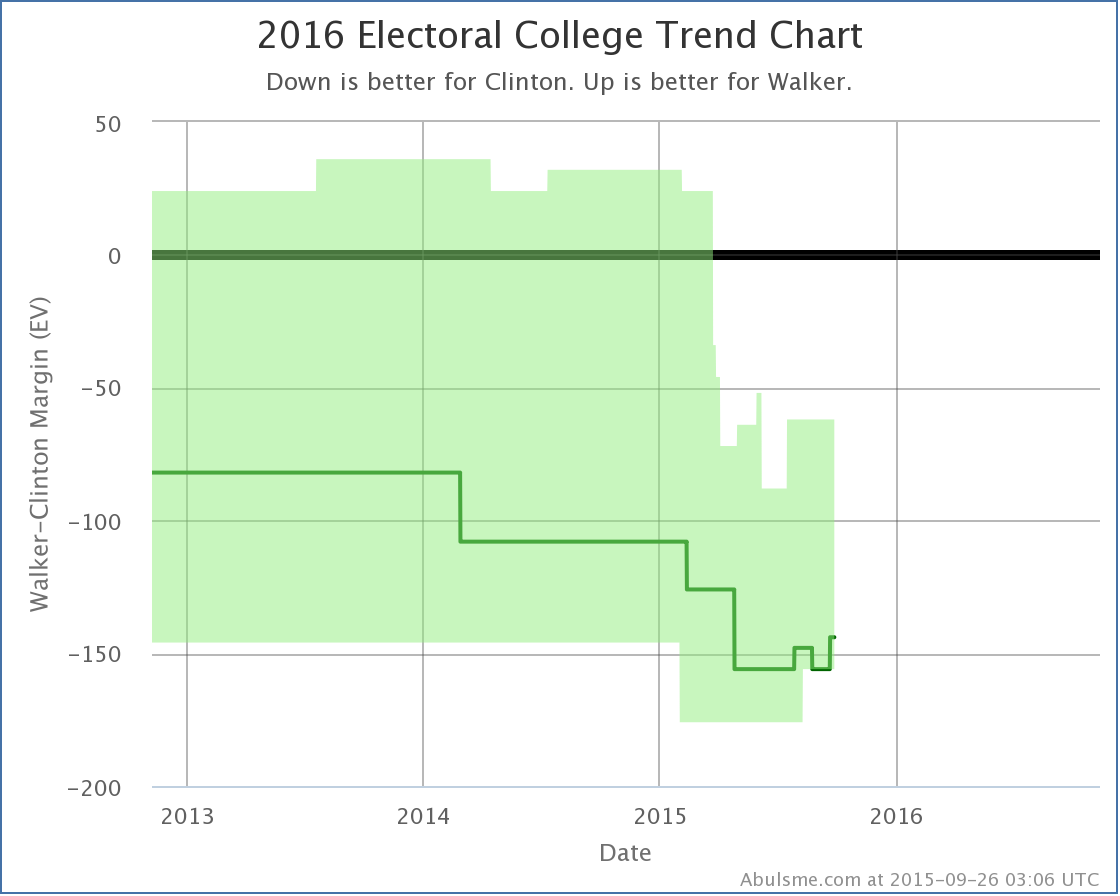
He increases his expected result to… losing by 144 electoral votes! Well, OK, Walker wasn’t the most competitive of the Republican candidates against Clinton.
Goodbye Walker.
409.8 days until polls start to close.
Note: This post is an update based on the data on ElectionGraphs.com. All of the charts and graphs seen here are from that site. Graphs, charts and raw data can be found there for the race nationally and in each state for every candidate combination that has been polled at the state level. In addition, comparisons of the best polled candidate combinations both nationally and each in each state are available. All charts above are clickable to go to the current version of the detail page the chart is from, which may contain more up to date information than the snapshots on this page, which were current as of the time of this post. Follow @ElecCollPolls on Twitter for specific poll details as I add them.
Clinton’s deterioration against the Republican field continues. There are two changes of note today, both show Republicans getting stronger against Clinton.
Clinton vs Rubio
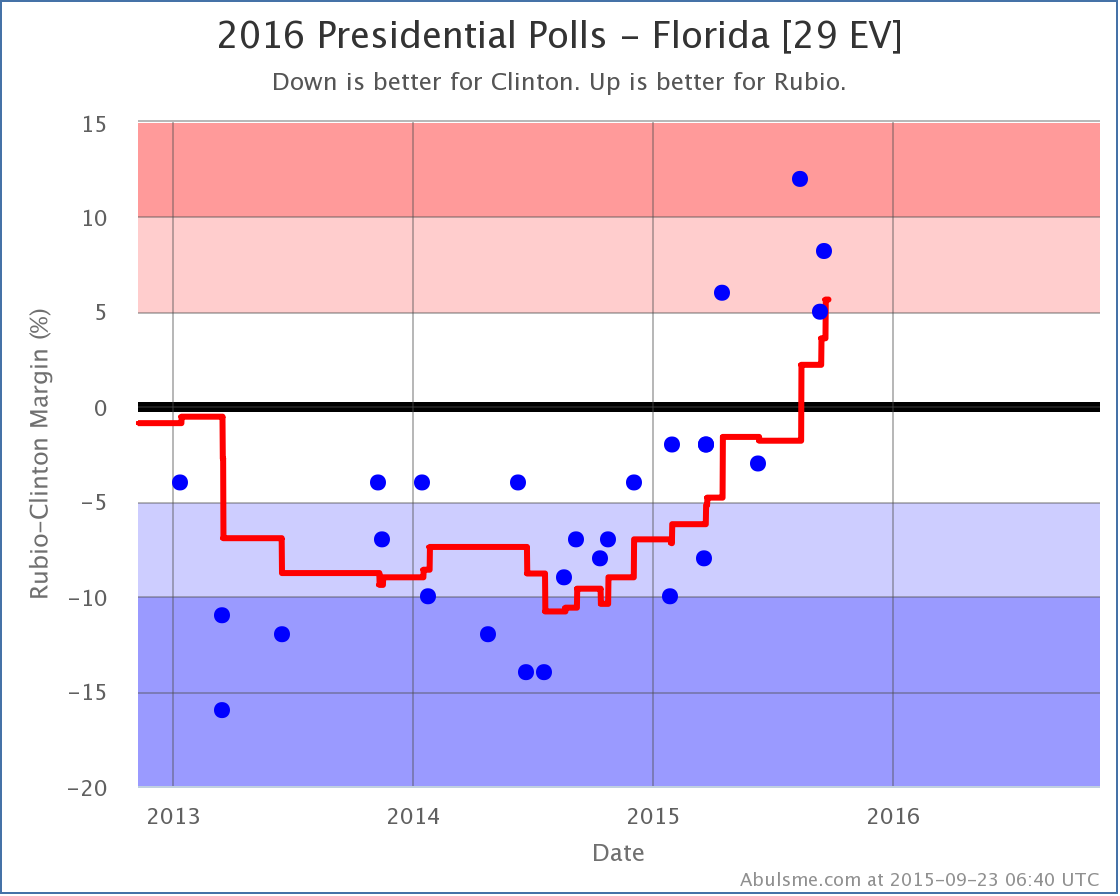
Clinton has now not been ahead in a Clinton vs Rubio poll in Florida since June. And four of the five polls in the average show Rubio leads of 5% or more. With the latest one of these polls, my poll average now shows Rubio’s lead in Florida as 5.6%. That takes Florida out of the “close state” category. So Clinton’s “best case” no longer includes winning Florida.
The scale of this collapse in Florida is particularly striking. As recently as last October, Clinton had a greater than 10% lead against Rubio in Florida. This put Florida in the “Solid Clinton” category. But over the course of the last year, that lead evaporated. And now Rubio is not just ahead, but significantly ahead. Now, this chart itself is a perfect example of how much things can change in a year. We are too far away for election day for this to be predictive of what would actually happen in Florida in a Clinton vs Rubio race next year. But this still looks very bad for Clinton.
The new situation summary for Clinton looks like this:
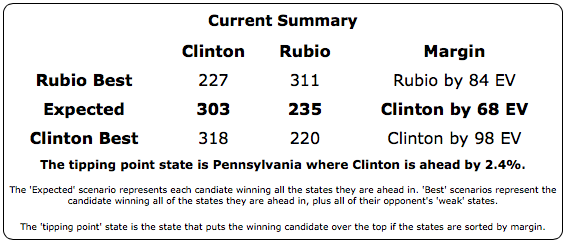
Clinton is still ahead… barely. But it is looking much more like a toss up. A tipping point of 2.4% could literally disappear overnight with the right events happening in the campaign. As recently as March, Rubio’s best case was to lose by 96 electoral votes. Now Clinton vs Rubio is too close to make a confident prediction, and even Clinton’s best case is deteriorating.
Florida is a big state, Florida is important. Clinton being this far behind in Florida is a significant issue for Clinton. Clinton doesn’t NEED Florida to win, but the paths without it are much tighter.
Clinton vs Bush
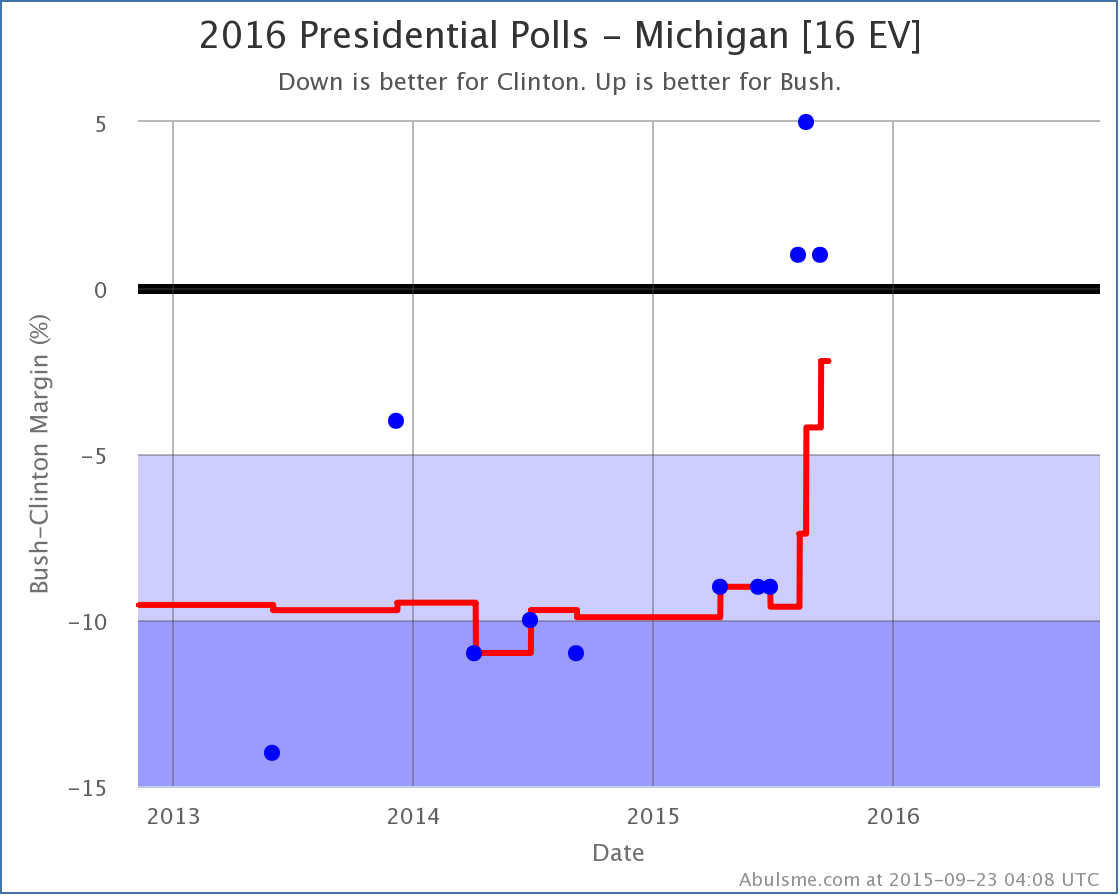
The latest results in Michigan for Clinton vs Bush don’t change the category of the state. It was “Weak Clinton” before the latest poll, and is “Weak Clinton” after the poll. But the move from Clinton by 4.2% to Clinton by 2.2% moved Michigan past several other states when you order the states by Clinton vs Bush margin, including moving past Ohio, which had been the tipping point state. Without Michigan to the left of Ohio, the tipping point moved from Clinton by 3.8% in Ohio, to Clinton by 2.4% in North Carolina.

Only four very close states, all with margins at 2.4% or less, need to flip to put Bush in the lead. In terms of tipping point, Clinton vs Bush is now tied with Clinton vs Rubio as the two of the five best polled candidate pairs that do the best against Clinton.
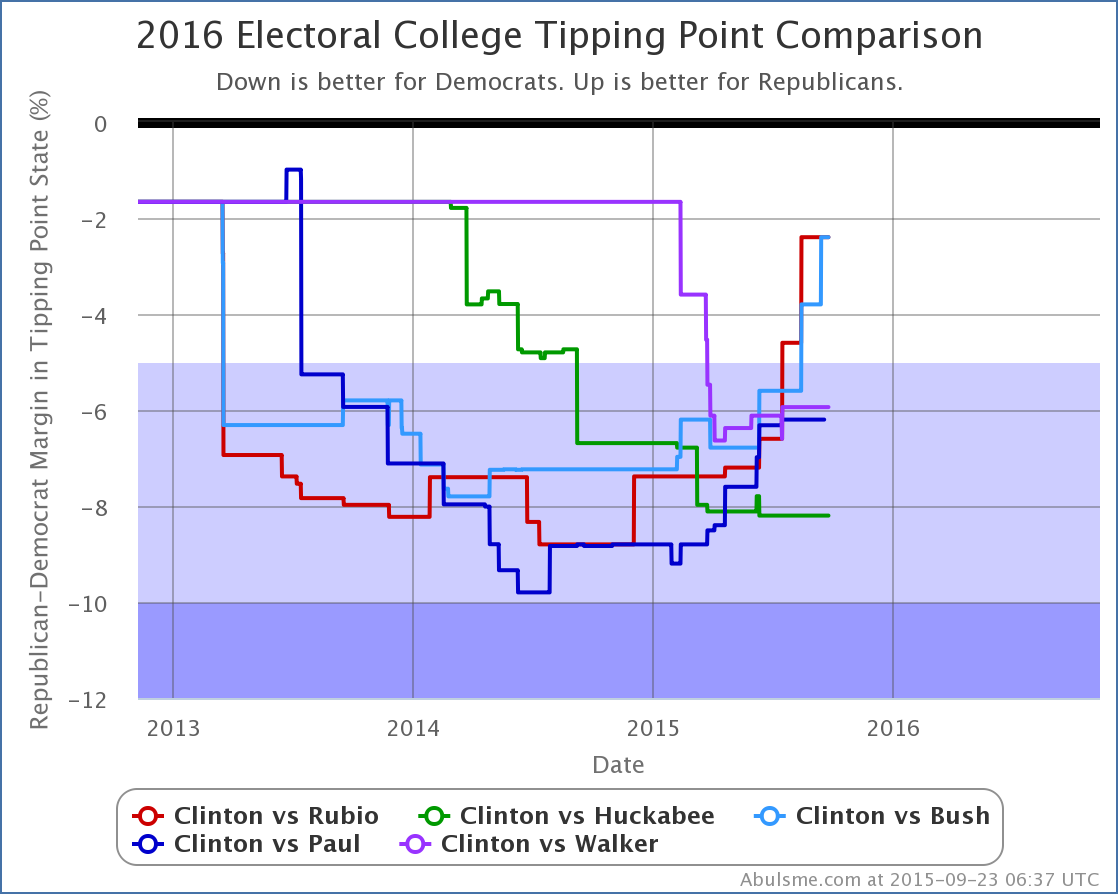
(Walker has of course now dropped out, he will likely be replaced in this comparison chart soon.)
When looking at the tipping point across these five candidate matches, while all but Huckabee made significant gains over Clinton in the last year, it is clear that in the last few months only Rubio and Bush have continued that movement in the last few months… but they have moved things significantly. The picture for the general election is starting to look very different depending on which Republican is up against Clinton.
What about Trump? Carson? Fiorina? Or what about Sanders and Biden? The bottom line is that compared to the candidates above, they simply have not been considered “serious candidates” for long enough to have a significant amount of state level polling. In my ranking of the best polled candidate combinations, Clinton vs Fiorina is #21, Clinton vs Carson is #22, Clinton vs Trump is #23. The highest combination with Sanders is #9. The highest with Biden is #10. You can look at these combinations if you want, but frankly there simply has not been enough polling yet on the state level to get a good picture of what those races really would look like, so interpret anything you see there with extreme caution.
412.4 days until polls start to close.
Note: This post is an update based on the data on ElectionGraphs.com. All of the charts and graphs seen here are from that site. Graphs, charts and raw data can be found there for the race nationally and in each state for every candidate combination that has been polled at the state level. In addition, comparisons of the best polled candidate combinations both nationally and each in each state are available. All charts above are clickable to go to the current version of the detail page the chart is from, which may contain more up to date information than the snapshots on this page, which were current as of the time of this post. Follow @ElecCollPolls on Twitter for specific poll details as I add them.
Well, last time I noted the “First good news for Clinton in months!“. I mentioned then that one data point does not make a trend. And today, with the next change worth noting to the five best polled candidate combinations, we indeed don’t get more good news for Clinton. Instead, this time we get Iowa flipping to Bush:
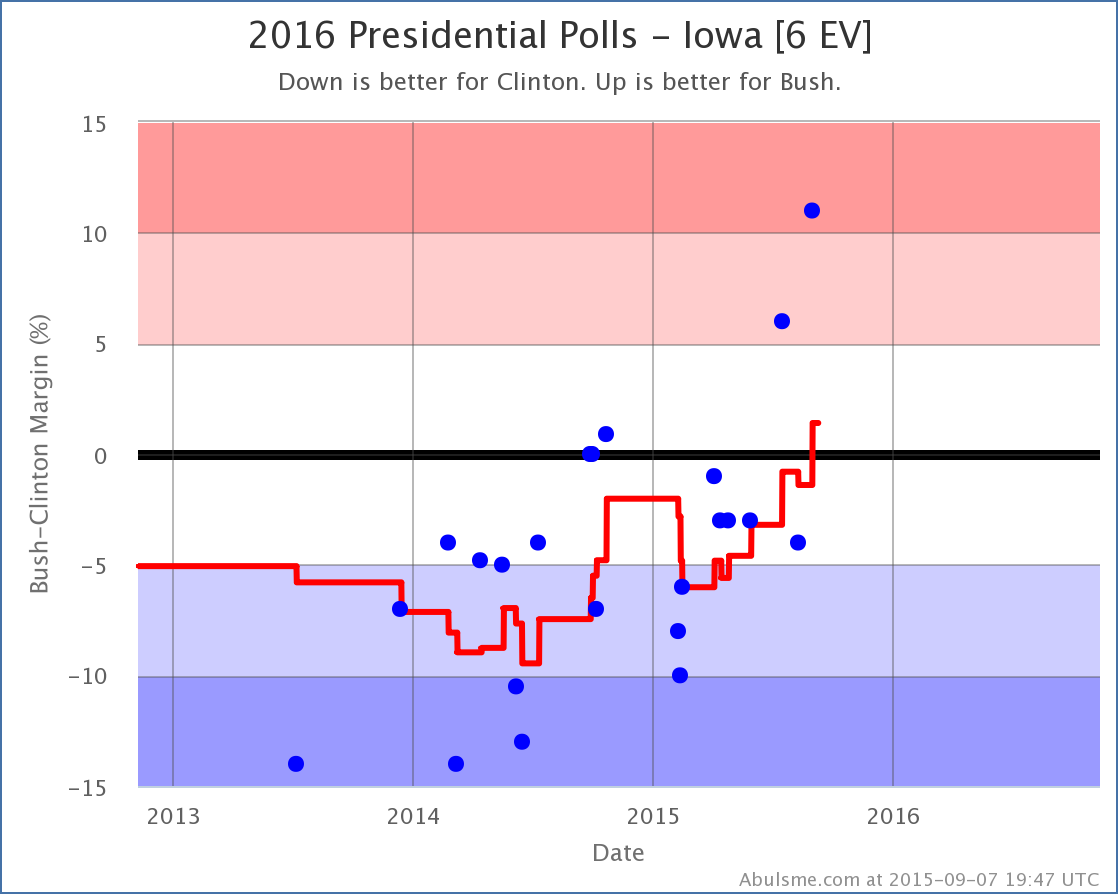
Only two of the last five polls in Iowa show a Bush lead, but they both show big leads. When averaged out, you have a 1.4% Bush margin… and a trend which has been moving away from Clinton since February. If the moves toward Hillary in New Hampshire mentioned in that last post were the start of any bottoming out for Clinton, there is no evidence of it here in Iowa. Indeed, if anything, the trend away from Clinton seems to be accelerating.
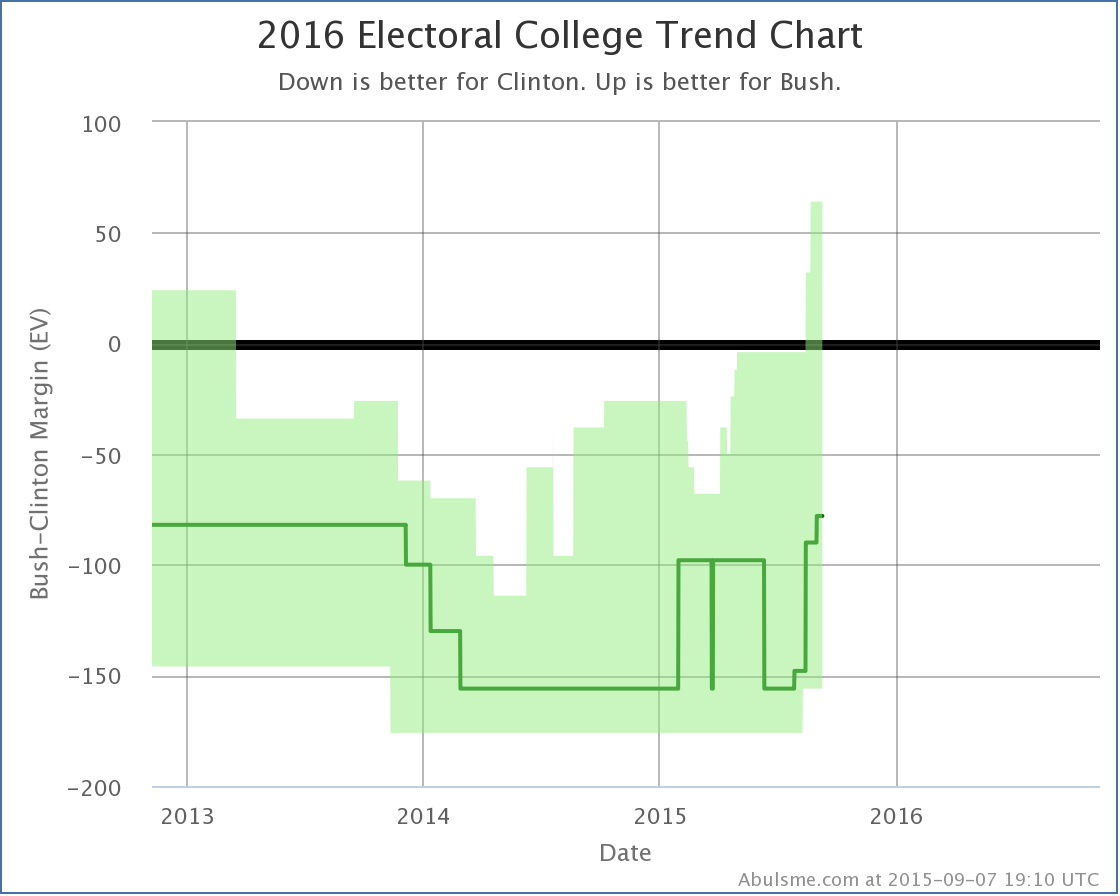
In the national Bush vs Clinton view, Bush is now losing by 78 electoral votes in the “expected” case where each candidate wins every state where they lead the poll averages. Yes, this is still a loss, but it is better than Bush has done in this matchup since the start of polling for 2016.
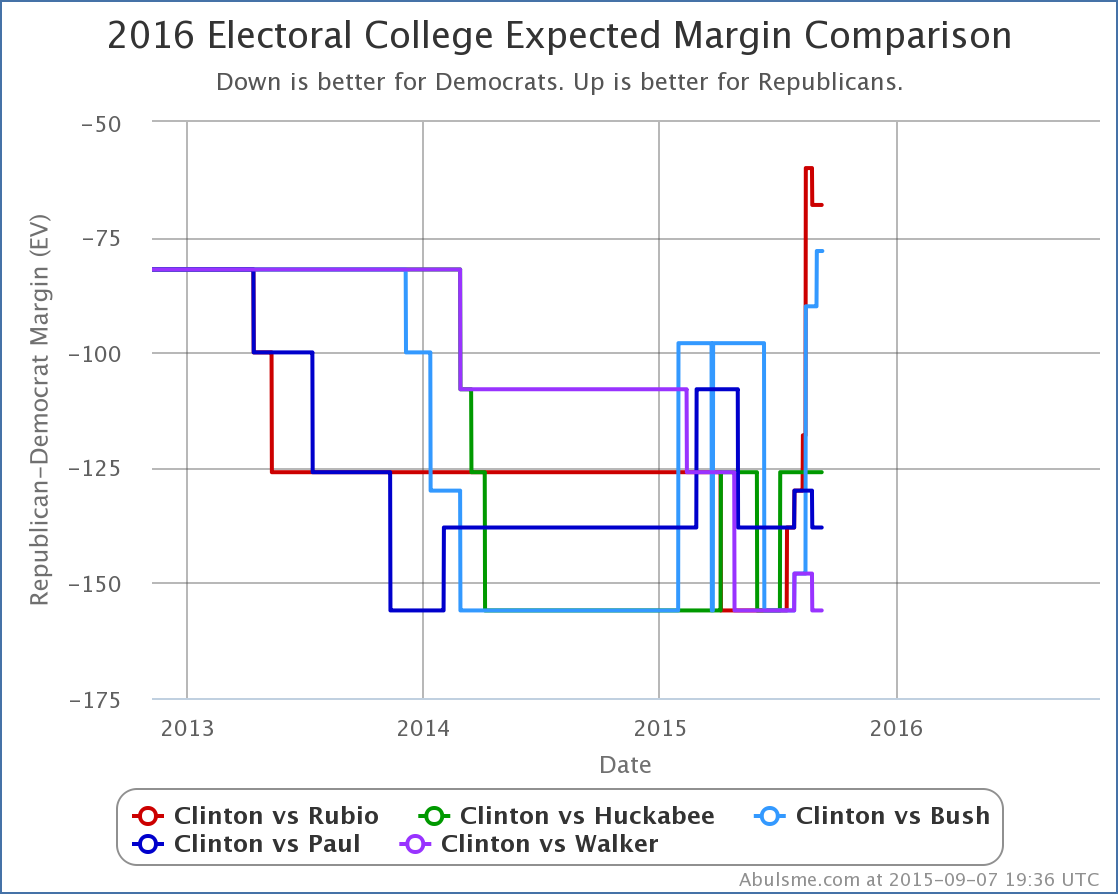
Looking at how Bush is doing compared to the rest of the best polled Republicans, Rubio is still doing better against Clinton, but Bush isn’t far behind. Huckabee, Paul and Walker’s margins against Clinton are significantly worse. In this particular view, they aren’t really gaining on Clinton at all. This doesn’t give the full picture though, as a quick look at the tipping point shows:
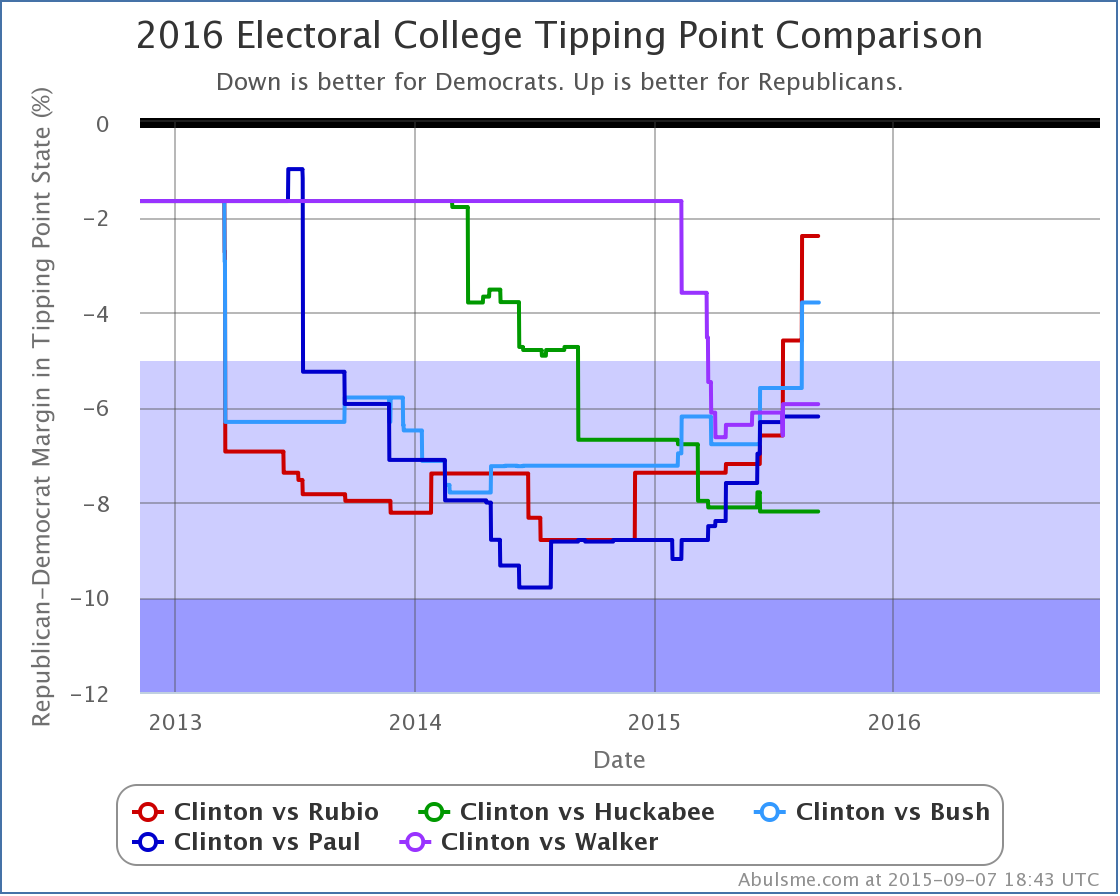
Bottom line, despite the move in her direction last time, the overall trends continue to be against Clinton. When and if this deterioration stops, and how that affects the primary races, is the big question of the campaign at the moment.
428.1 days until the first general election polls close.
Note: This post is an update based on the data on ElectionGraphs.com. All of the charts and graphs seen here are from that site. Graphs, charts and raw data can be found there for the race nationally and in each state for every candidate combination that has been polled at the state level. In addition, comparisons of the best polled candidate combinations both nationally and each in each state are available. All charts above are clickable to go to the current version of the detail page the chart is from, which may contain more up to date information than the snapshots on this page, which were current as of the time of this post. Follow @ElecCollPolls on Twitter for specific poll details as I add them.
I’ve mentioned a number of times at this point that Clinton has had a long streak of bad news. The last time one of my updates was unambiguously positive for Clinton was back in May! That streak ends today, with movement in New Hampshire prompted by a new PPP poll.
Three of the top five best polled candidate combinations flipped from “Weak Republican” to “Weak Clinton” because of this update:
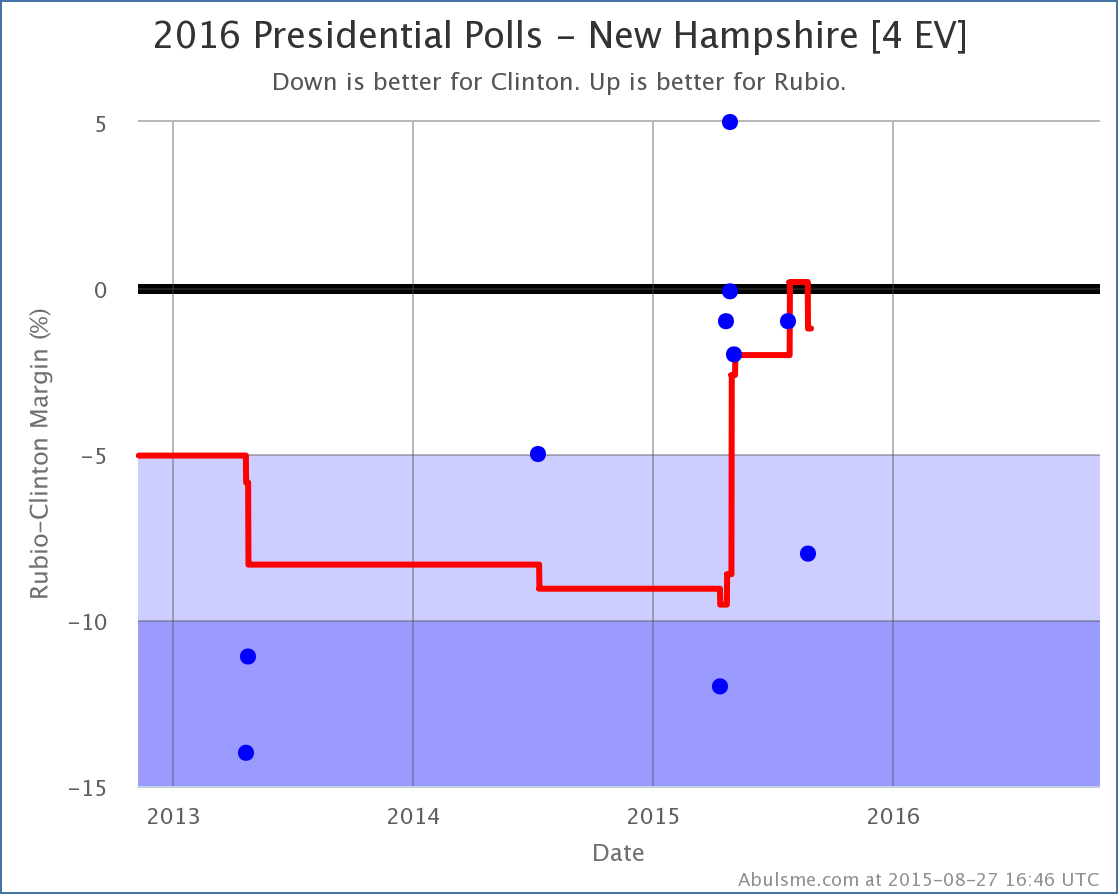
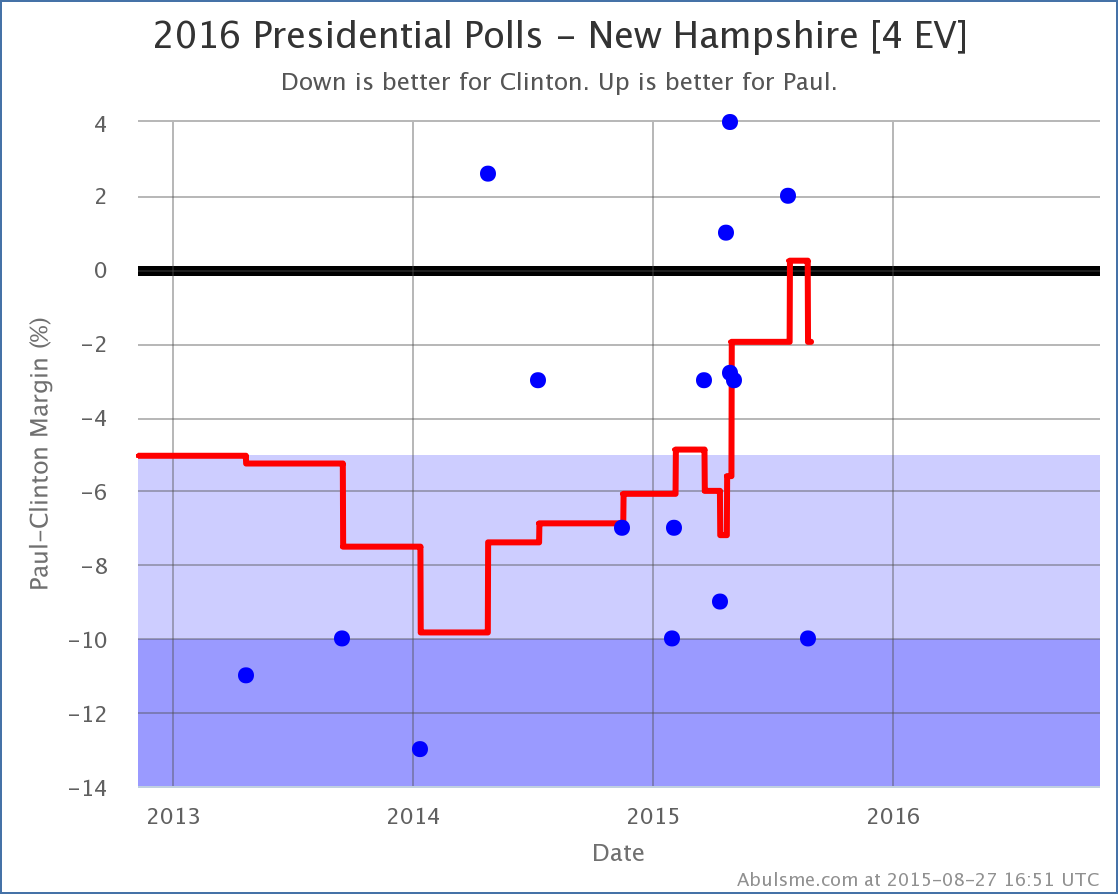
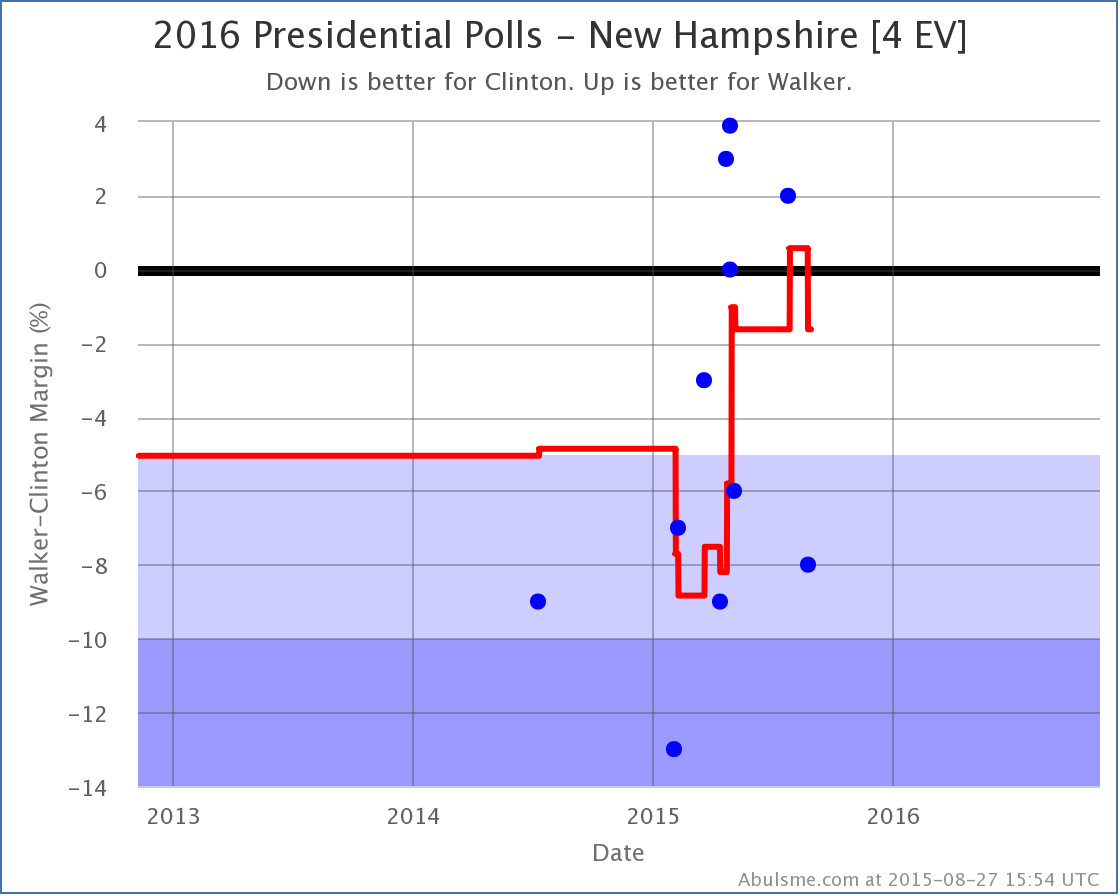
So for Rubio, Paul and Walker, New Hampshire flips back to blue (although not by much). Clinton vs Bush just narrowly avoided doing the same thing, as Bush’s margin declined from 1.6% to 0.2%, but didn’t quite pass over the line.
New Hampshire is a little state. Only 4 electoral votes. If you look at the “expected cases” this just makes a small move for each of these three candidates:
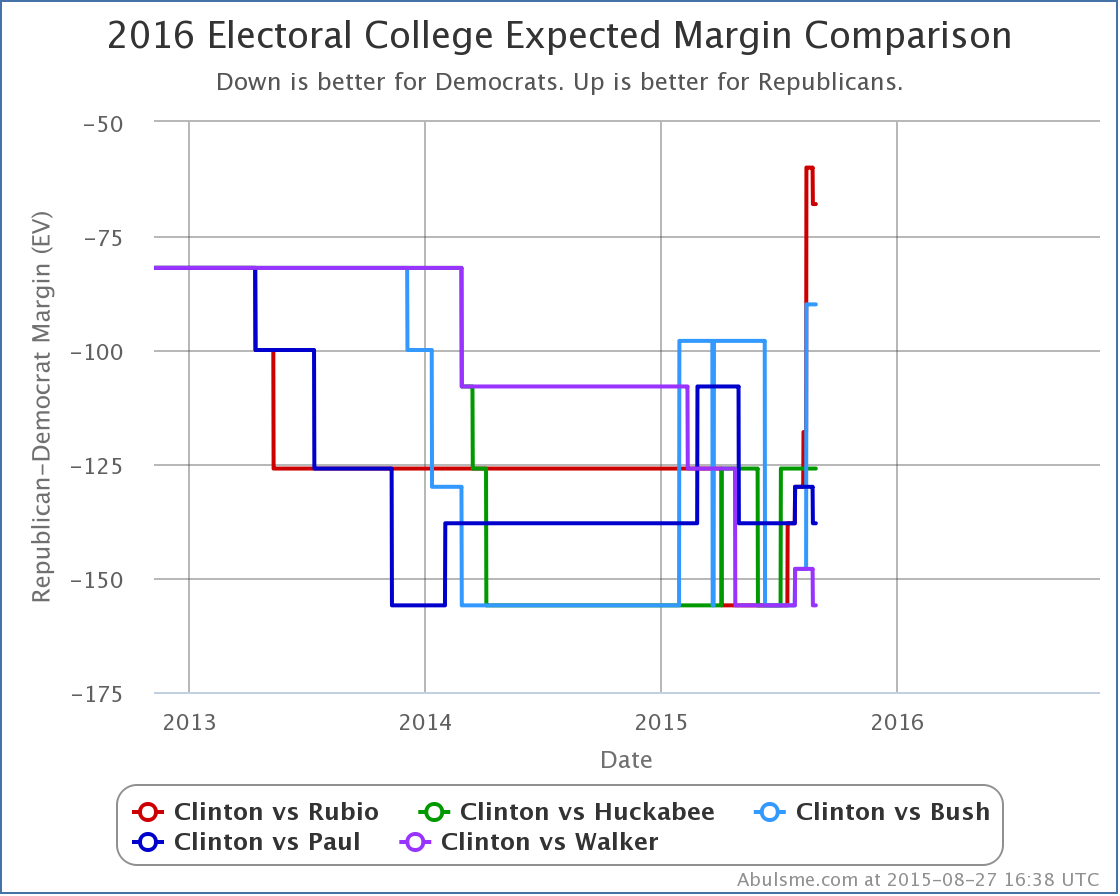
As a move, this isn’t all that much. And Clinton is significantly ahead on this metric against all five Republicans. So New Hampshire’s electoral votes aren’t determining the outcome here.
But after three months solid of posts where I’ve been talking about how the Republican position is getting stronger, and Clinton’s position was getting weaker, is there significance to a move, any move, actually going in Clinton’s direction? Well, maybe. But one point does not make a trend.
This could be an indicator that Clinton has bottomed for now and we’re not going to see further declines for the time being. Or, just as easily, perhaps these PPP results are a significant outlier, and not representative of an actual change of mood in New Hampshire, in which case the next New Hampshire polls may pull the state back into the red zone.
As usual, we will just have to wait and see. In the meantime though, Clinton’s losing streak has been broken.
493.0 days until polls start closing.
Note: This post is an update based on the data on ElectionGraphs.com. All of the charts and graphs seen here are from that site. Graphs, charts and raw data can be found there for the race nationally and in each state for every candidate combination that has been polled at the state level. In addition, comparisons of the best polled candidate combinations both nationally and each in each state are available. All charts above are clickable to go to the current version of the detail page the chart is from, which may contain more up to date information than the snapshots on this page, which were current as of the time of this post. Follow @ElecCollPolls on Twitter for specific poll details as I add them.
|
|












































